Technology Effect on Future of University Learning Education
VerifiedAdded on 2021/04/21
|22
|5124
|592
Report
AI Summary
This report examines the transformative impact of technology on university learning and education. It begins by outlining the historical shift from traditional teaching methods to modern, technology-driven approaches, highlighting the evolution of educational practices. The report delves into the positive and negative effects of technological integration, including the rise of online learning, e-learning platforms, and the use of digital tools. It explores the challenges faced in implementing these changes, such as infrastructure limitations and the need for digital literacy. Furthermore, the report analyzes research objectives, questions, and methodologies, providing insights into the significance of technology in the 21st-century education system. The report highlights the significance of research in supporting the significance of 21st-century society in order to modernize the behavior of thinking among students.
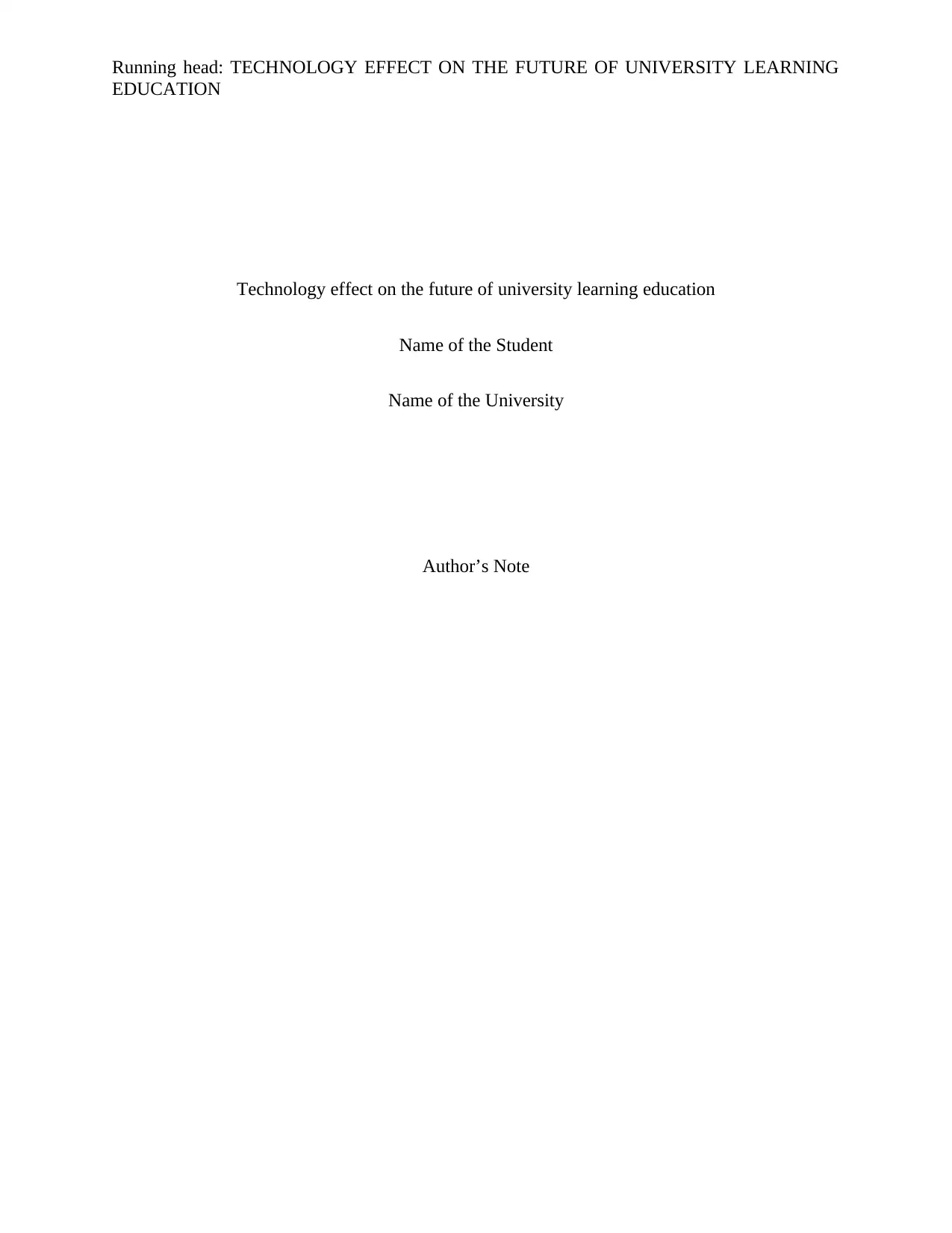
Running head: TECHNOLOGY EFFECT ON THE FUTURE OF UNIVERSITY LEARNING
EDUCATION
Technology effect on the future of university learning education
Name of the Student
Name of the University
Author’s Note
EDUCATION
Technology effect on the future of university learning education
Name of the Student
Name of the University
Author’s Note
Secure Best Marks with AI Grader
Need help grading? Try our AI Grader for instant feedback on your assignments.
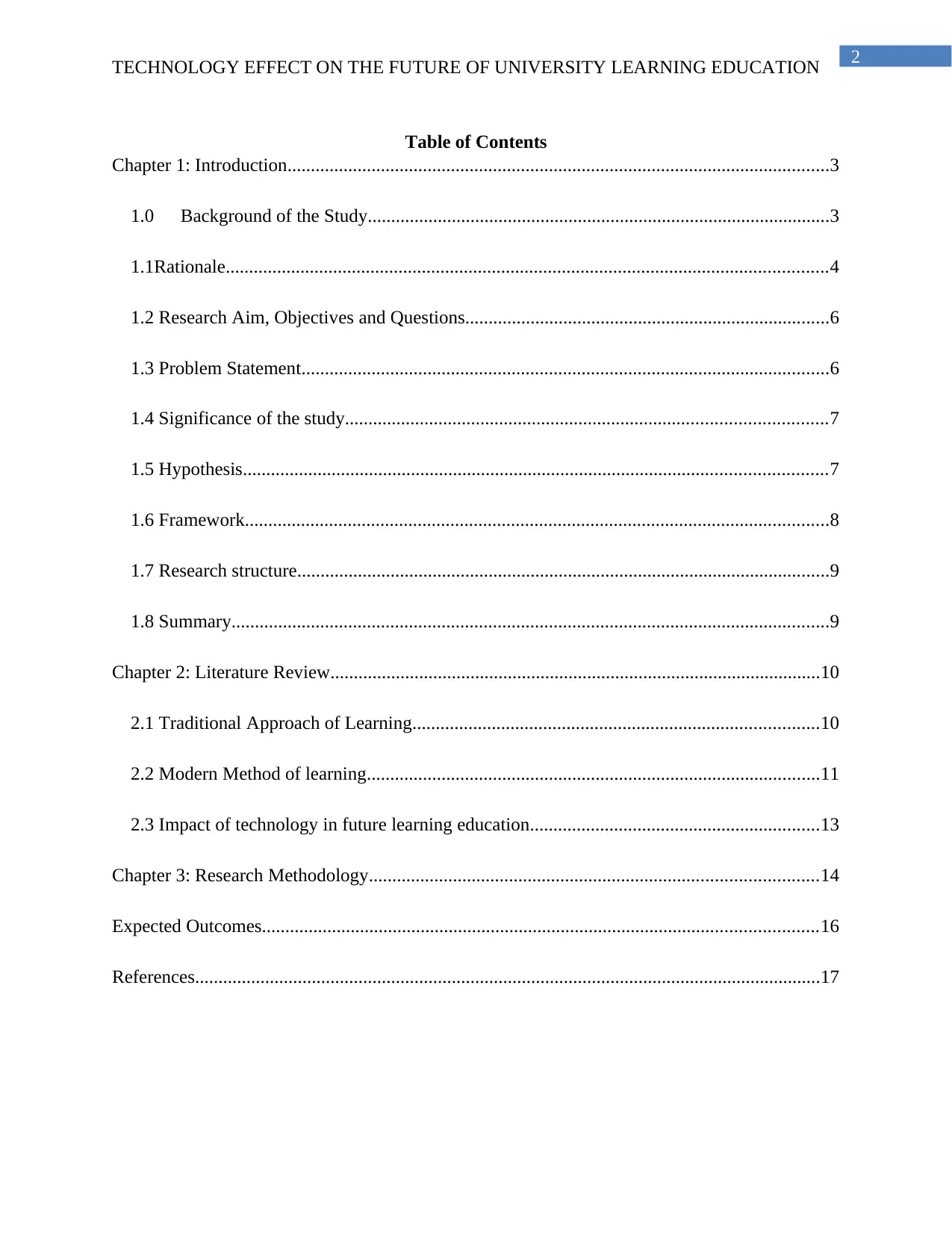
2
TECHNOLOGY EFFECT ON THE FUTURE OF UNIVERSITY LEARNING EDUCATION
Table of Contents
Chapter 1: Introduction....................................................................................................................3
1.0 Background of the Study...................................................................................................3
1.1Rationale.................................................................................................................................4
1.2 Research Aim, Objectives and Questions..............................................................................6
1.3 Problem Statement.................................................................................................................6
1.4 Significance of the study.......................................................................................................7
1.5 Hypothesis.............................................................................................................................7
1.6 Framework.............................................................................................................................8
1.7 Research structure..................................................................................................................9
1.8 Summary................................................................................................................................9
Chapter 2: Literature Review.........................................................................................................10
2.1 Traditional Approach of Learning.......................................................................................10
2.2 Modern Method of learning.................................................................................................11
2.3 Impact of technology in future learning education..............................................................13
Chapter 3: Research Methodology................................................................................................14
Expected Outcomes.......................................................................................................................16
References......................................................................................................................................17
TECHNOLOGY EFFECT ON THE FUTURE OF UNIVERSITY LEARNING EDUCATION
Table of Contents
Chapter 1: Introduction....................................................................................................................3
1.0 Background of the Study...................................................................................................3
1.1Rationale.................................................................................................................................4
1.2 Research Aim, Objectives and Questions..............................................................................6
1.3 Problem Statement.................................................................................................................6
1.4 Significance of the study.......................................................................................................7
1.5 Hypothesis.............................................................................................................................7
1.6 Framework.............................................................................................................................8
1.7 Research structure..................................................................................................................9
1.8 Summary................................................................................................................................9
Chapter 2: Literature Review.........................................................................................................10
2.1 Traditional Approach of Learning.......................................................................................10
2.2 Modern Method of learning.................................................................................................11
2.3 Impact of technology in future learning education..............................................................13
Chapter 3: Research Methodology................................................................................................14
Expected Outcomes.......................................................................................................................16
References......................................................................................................................................17
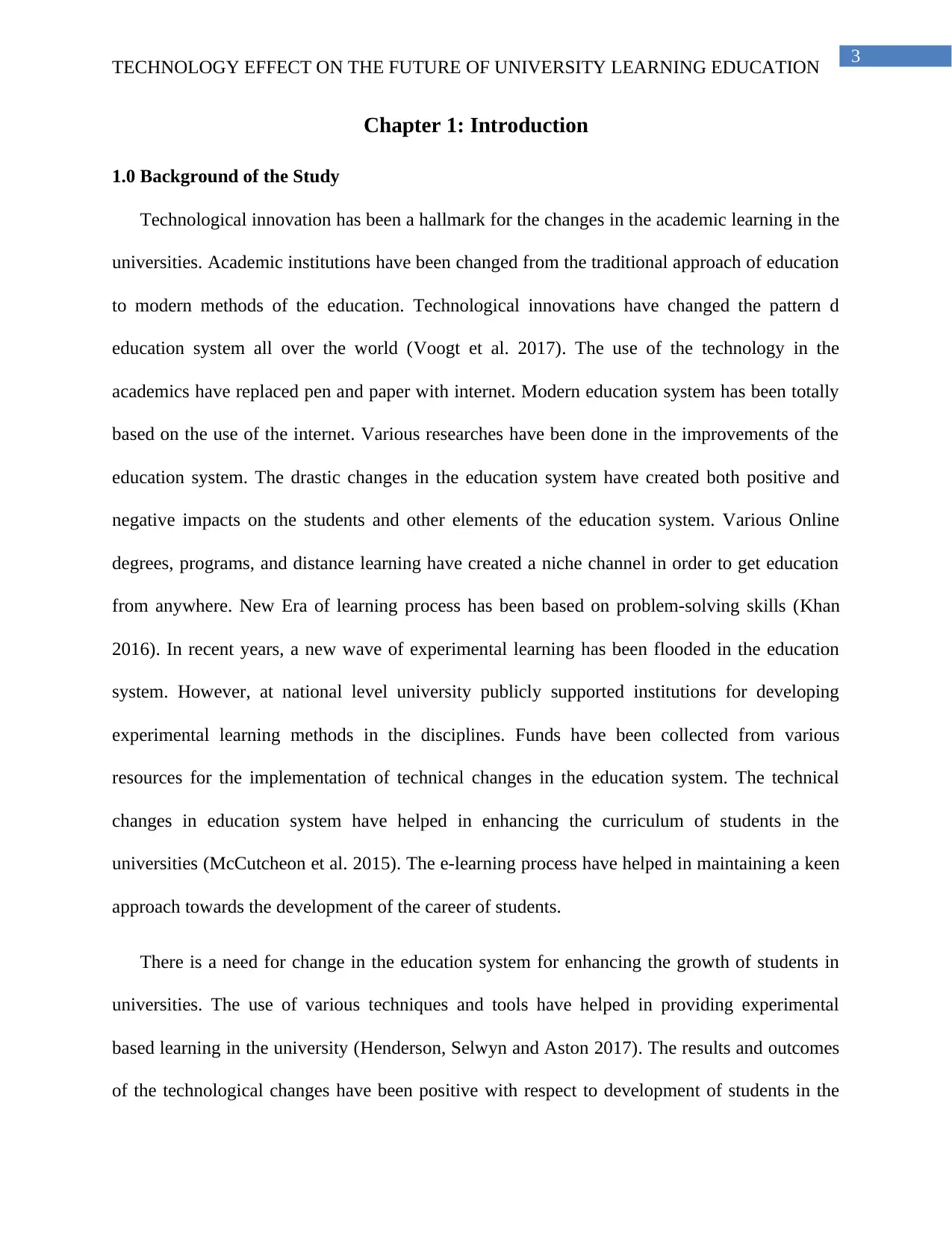
3
TECHNOLOGY EFFECT ON THE FUTURE OF UNIVERSITY LEARNING EDUCATION
Chapter 1: Introduction
1.0 Background of the Study
Technological innovation has been a hallmark for the changes in the academic learning in the
universities. Academic institutions have been changed from the traditional approach of education
to modern methods of the education. Technological innovations have changed the pattern d
education system all over the world (Voogt et al. 2017). The use of the technology in the
academics have replaced pen and paper with internet. Modern education system has been totally
based on the use of the internet. Various researches have been done in the improvements of the
education system. The drastic changes in the education system have created both positive and
negative impacts on the students and other elements of the education system. Various Online
degrees, programs, and distance learning have created a niche channel in order to get education
from anywhere. New Era of learning process has been based on problem-solving skills (Khan
2016). In recent years, a new wave of experimental learning has been flooded in the education
system. However, at national level university publicly supported institutions for developing
experimental learning methods in the disciplines. Funds have been collected from various
resources for the implementation of technical changes in the education system. The technical
changes in education system have helped in enhancing the curriculum of students in the
universities (McCutcheon et al. 2015). The e-learning process have helped in maintaining a keen
approach towards the development of the career of students.
There is a need for change in the education system for enhancing the growth of students in
universities. The use of various techniques and tools have helped in providing experimental
based learning in the university (Henderson, Selwyn and Aston 2017). The results and outcomes
of the technological changes have been positive with respect to development of students in the
TECHNOLOGY EFFECT ON THE FUTURE OF UNIVERSITY LEARNING EDUCATION
Chapter 1: Introduction
1.0 Background of the Study
Technological innovation has been a hallmark for the changes in the academic learning in the
universities. Academic institutions have been changed from the traditional approach of education
to modern methods of the education. Technological innovations have changed the pattern d
education system all over the world (Voogt et al. 2017). The use of the technology in the
academics have replaced pen and paper with internet. Modern education system has been totally
based on the use of the internet. Various researches have been done in the improvements of the
education system. The drastic changes in the education system have created both positive and
negative impacts on the students and other elements of the education system. Various Online
degrees, programs, and distance learning have created a niche channel in order to get education
from anywhere. New Era of learning process has been based on problem-solving skills (Khan
2016). In recent years, a new wave of experimental learning has been flooded in the education
system. However, at national level university publicly supported institutions for developing
experimental learning methods in the disciplines. Funds have been collected from various
resources for the implementation of technical changes in the education system. The technical
changes in education system have helped in enhancing the curriculum of students in the
universities (McCutcheon et al. 2015). The e-learning process have helped in maintaining a keen
approach towards the development of the career of students.
There is a need for change in the education system for enhancing the growth of students in
universities. The use of various techniques and tools have helped in providing experimental
based learning in the university (Henderson, Selwyn and Aston 2017). The results and outcomes
of the technological changes have been positive with respect to development of students in the
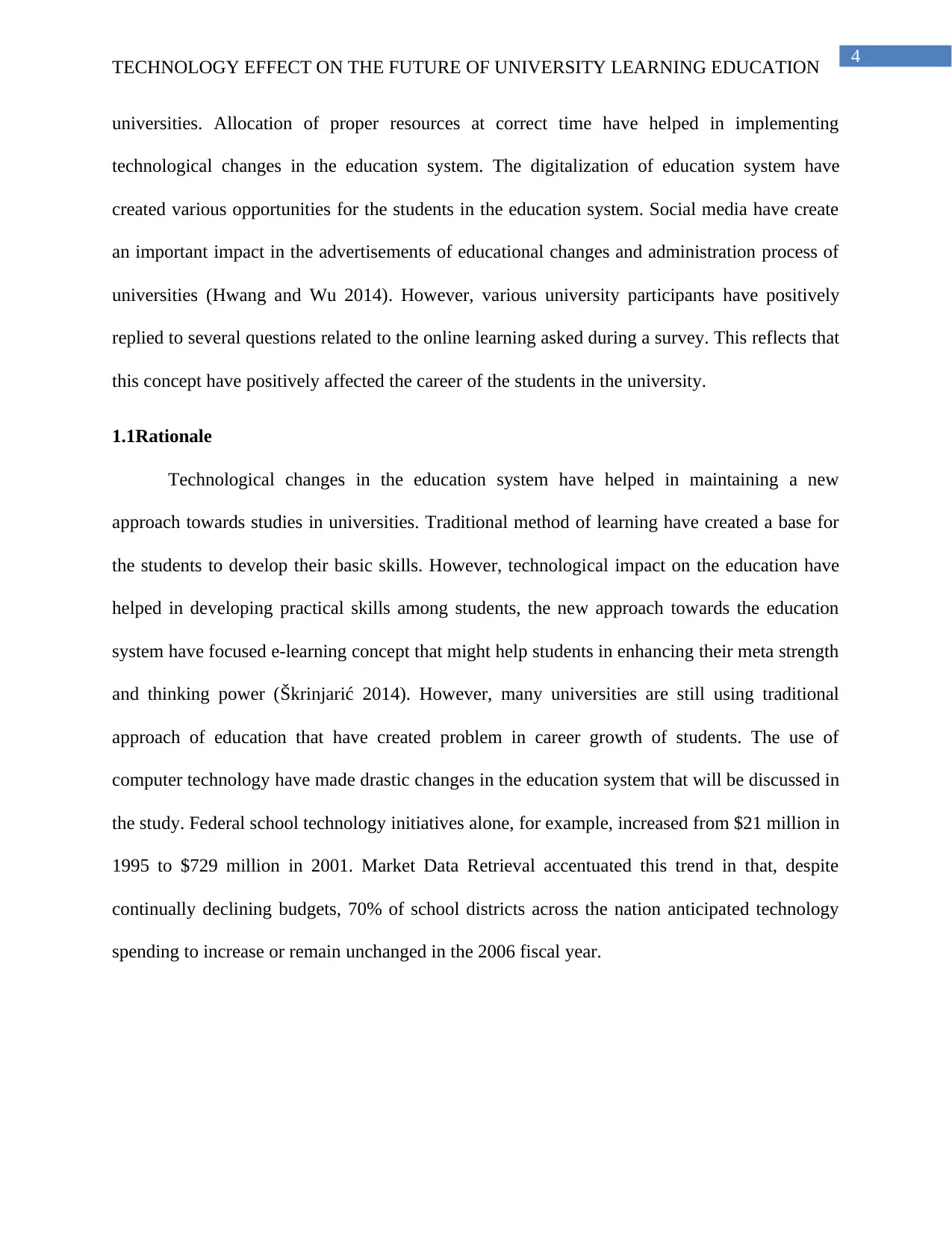
4
TECHNOLOGY EFFECT ON THE FUTURE OF UNIVERSITY LEARNING EDUCATION
universities. Allocation of proper resources at correct time have helped in implementing
technological changes in the education system. The digitalization of education system have
created various opportunities for the students in the education system. Social media have create
an important impact in the advertisements of educational changes and administration process of
universities (Hwang and Wu 2014). However, various university participants have positively
replied to several questions related to the online learning asked during a survey. This reflects that
this concept have positively affected the career of the students in the university.
1.1Rationale
Technological changes in the education system have helped in maintaining a new
approach towards studies in universities. Traditional method of learning have created a base for
the students to develop their basic skills. However, technological impact on the education have
helped in developing practical skills among students, the new approach towards the education
system have focused e-learning concept that might help students in enhancing their meta strength
and thinking power (Škrinjarić 2014). However, many universities are still using traditional
approach of education that have created problem in career growth of students. The use of
computer technology have made drastic changes in the education system that will be discussed in
the study. Federal school technology initiatives alone, for example, increased from $21 million in
1995 to $729 million in 2001. Market Data Retrieval accentuated this trend in that, despite
continually declining budgets, 70% of school districts across the nation anticipated technology
spending to increase or remain unchanged in the 2006 fiscal year.
TECHNOLOGY EFFECT ON THE FUTURE OF UNIVERSITY LEARNING EDUCATION
universities. Allocation of proper resources at correct time have helped in implementing
technological changes in the education system. The digitalization of education system have
created various opportunities for the students in the education system. Social media have create
an important impact in the advertisements of educational changes and administration process of
universities (Hwang and Wu 2014). However, various university participants have positively
replied to several questions related to the online learning asked during a survey. This reflects that
this concept have positively affected the career of the students in the university.
1.1Rationale
Technological changes in the education system have helped in maintaining a new
approach towards studies in universities. Traditional method of learning have created a base for
the students to develop their basic skills. However, technological impact on the education have
helped in developing practical skills among students, the new approach towards the education
system have focused e-learning concept that might help students in enhancing their meta strength
and thinking power (Škrinjarić 2014). However, many universities are still using traditional
approach of education that have created problem in career growth of students. The use of
computer technology have made drastic changes in the education system that will be discussed in
the study. Federal school technology initiatives alone, for example, increased from $21 million in
1995 to $729 million in 2001. Market Data Retrieval accentuated this trend in that, despite
continually declining budgets, 70% of school districts across the nation anticipated technology
spending to increase or remain unchanged in the 2006 fiscal year.
Secure Best Marks with AI Grader
Need help grading? Try our AI Grader for instant feedback on your assignments.
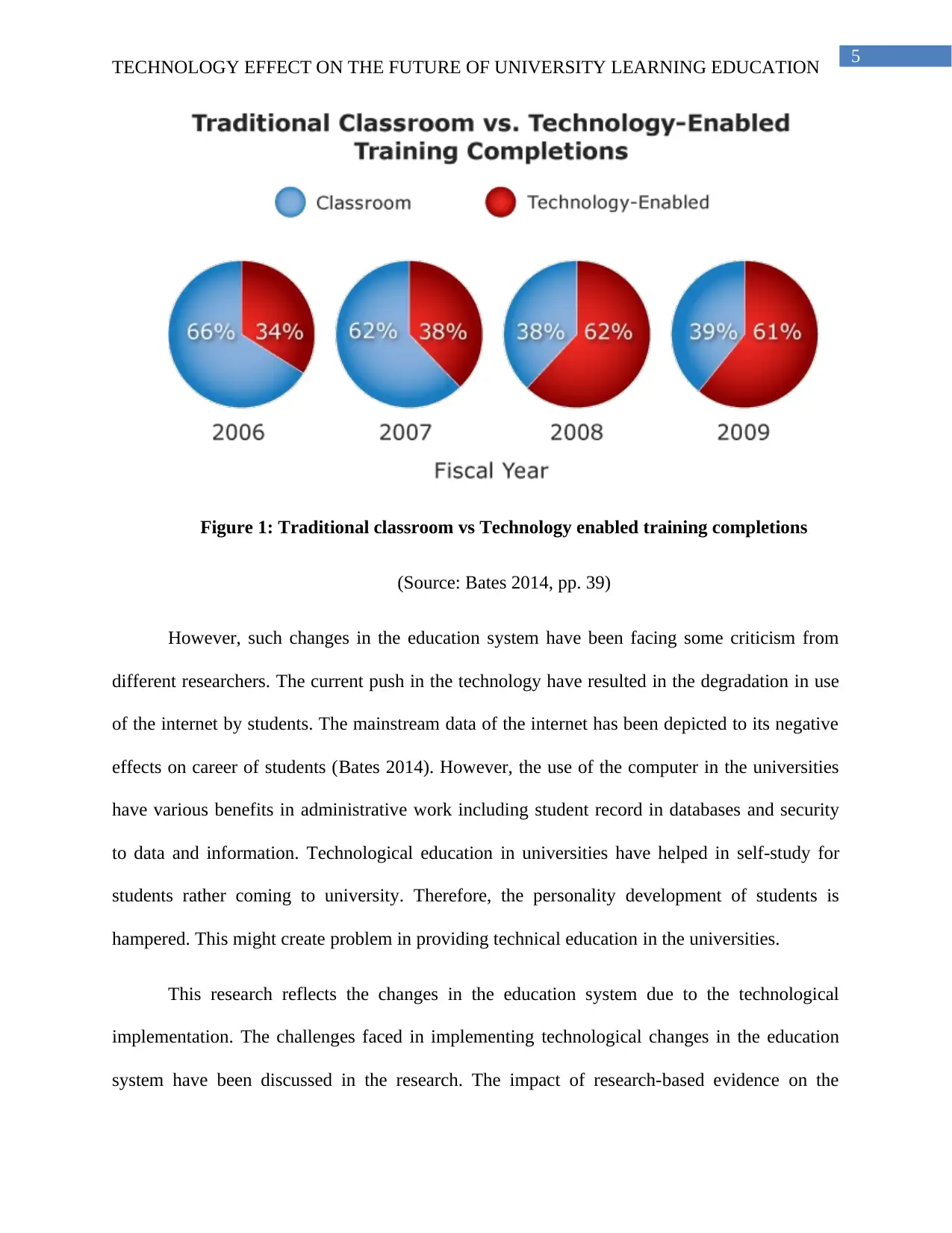
5
TECHNOLOGY EFFECT ON THE FUTURE OF UNIVERSITY LEARNING EDUCATION
Figure 1: Traditional classroom vs Technology enabled training completions
(Source: Bates 2014, pp. 39)
However, such changes in the education system have been facing some criticism from
different researchers. The current push in the technology have resulted in the degradation in use
of the internet by students. The mainstream data of the internet has been depicted to its negative
effects on career of students (Bates 2014). However, the use of the computer in the universities
have various benefits in administrative work including student record in databases and security
to data and information. Technological education in universities have helped in self-study for
students rather coming to university. Therefore, the personality development of students is
hampered. This might create problem in providing technical education in the universities.
This research reflects the changes in the education system due to the technological
implementation. The challenges faced in implementing technological changes in the education
system have been discussed in the research. The impact of research-based evidence on the
TECHNOLOGY EFFECT ON THE FUTURE OF UNIVERSITY LEARNING EDUCATION
Figure 1: Traditional classroom vs Technology enabled training completions
(Source: Bates 2014, pp. 39)
However, such changes in the education system have been facing some criticism from
different researchers. The current push in the technology have resulted in the degradation in use
of the internet by students. The mainstream data of the internet has been depicted to its negative
effects on career of students (Bates 2014). However, the use of the computer in the universities
have various benefits in administrative work including student record in databases and security
to data and information. Technological education in universities have helped in self-study for
students rather coming to university. Therefore, the personality development of students is
hampered. This might create problem in providing technical education in the universities.
This research reflects the changes in the education system due to the technological
implementation. The challenges faced in implementing technological changes in the education
system have been discussed in the research. The impact of research-based evidence on the
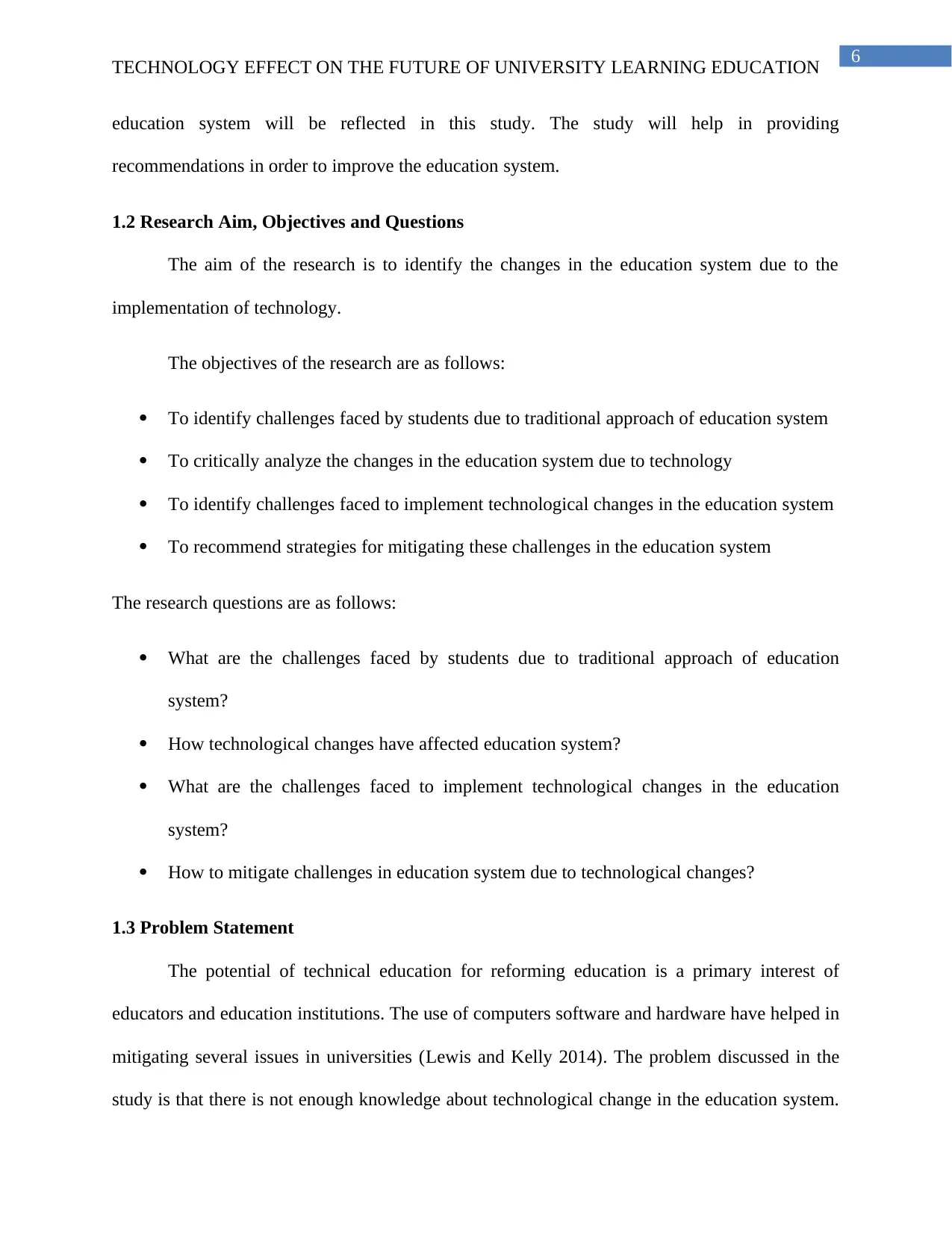
6
TECHNOLOGY EFFECT ON THE FUTURE OF UNIVERSITY LEARNING EDUCATION
education system will be reflected in this study. The study will help in providing
recommendations in order to improve the education system.
1.2 Research Aim, Objectives and Questions
The aim of the research is to identify the changes in the education system due to the
implementation of technology.
The objectives of the research are as follows:
To identify challenges faced by students due to traditional approach of education system
To critically analyze the changes in the education system due to technology
To identify challenges faced to implement technological changes in the education system
To recommend strategies for mitigating these challenges in the education system
The research questions are as follows:
What are the challenges faced by students due to traditional approach of education
system?
How technological changes have affected education system?
What are the challenges faced to implement technological changes in the education
system?
How to mitigate challenges in education system due to technological changes?
1.3 Problem Statement
The potential of technical education for reforming education is a primary interest of
educators and education institutions. The use of computers software and hardware have helped in
mitigating several issues in universities (Lewis and Kelly 2014). The problem discussed in the
study is that there is not enough knowledge about technological change in the education system.
TECHNOLOGY EFFECT ON THE FUTURE OF UNIVERSITY LEARNING EDUCATION
education system will be reflected in this study. The study will help in providing
recommendations in order to improve the education system.
1.2 Research Aim, Objectives and Questions
The aim of the research is to identify the changes in the education system due to the
implementation of technology.
The objectives of the research are as follows:
To identify challenges faced by students due to traditional approach of education system
To critically analyze the changes in the education system due to technology
To identify challenges faced to implement technological changes in the education system
To recommend strategies for mitigating these challenges in the education system
The research questions are as follows:
What are the challenges faced by students due to traditional approach of education
system?
How technological changes have affected education system?
What are the challenges faced to implement technological changes in the education
system?
How to mitigate challenges in education system due to technological changes?
1.3 Problem Statement
The potential of technical education for reforming education is a primary interest of
educators and education institutions. The use of computers software and hardware have helped in
mitigating several issues in universities (Lewis and Kelly 2014). The problem discussed in the
study is that there is not enough knowledge about technological change in the education system.
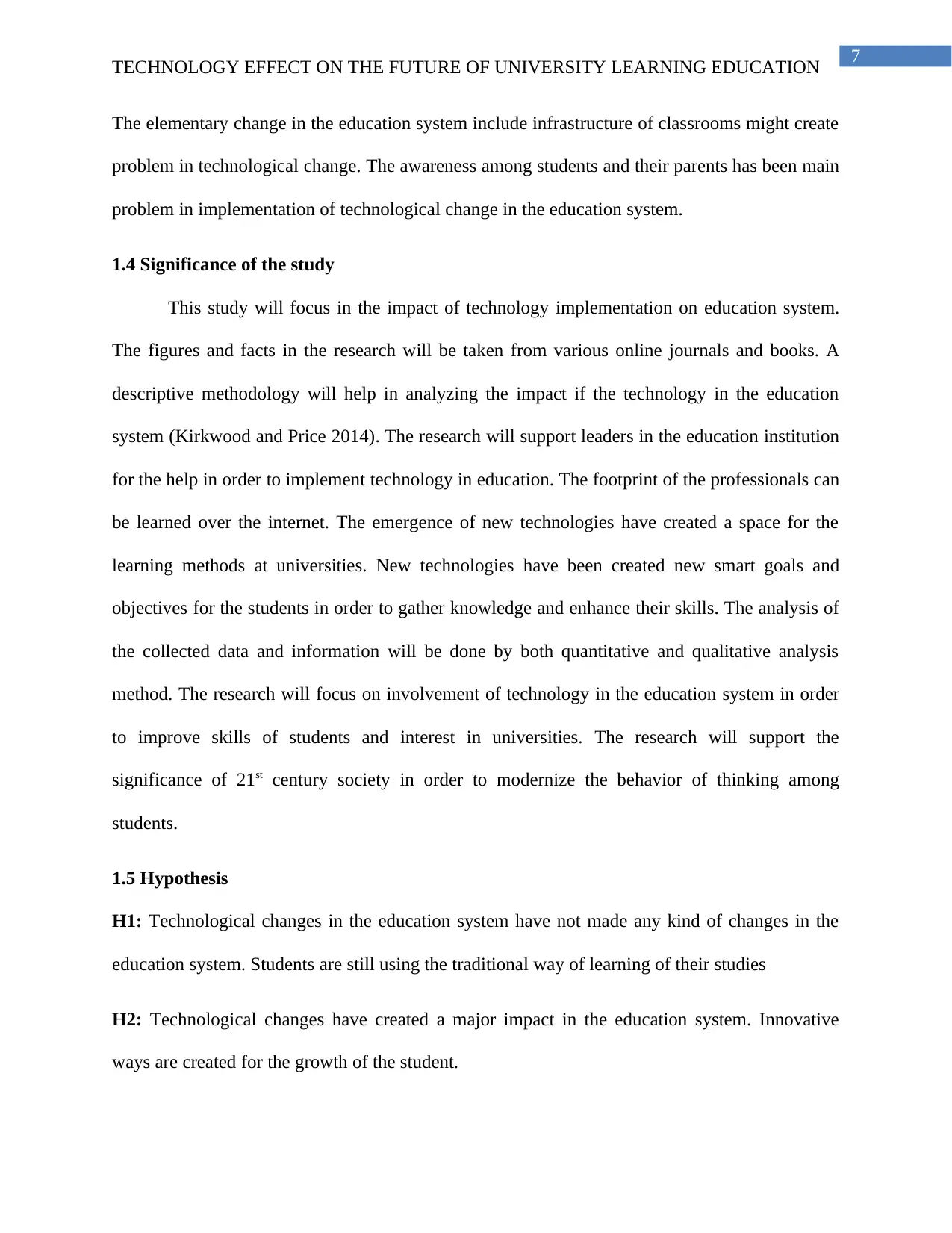
7
TECHNOLOGY EFFECT ON THE FUTURE OF UNIVERSITY LEARNING EDUCATION
The elementary change in the education system include infrastructure of classrooms might create
problem in technological change. The awareness among students and their parents has been main
problem in implementation of technological change in the education system.
1.4 Significance of the study
This study will focus in the impact of technology implementation on education system.
The figures and facts in the research will be taken from various online journals and books. A
descriptive methodology will help in analyzing the impact if the technology in the education
system (Kirkwood and Price 2014). The research will support leaders in the education institution
for the help in order to implement technology in education. The footprint of the professionals can
be learned over the internet. The emergence of new technologies have created a space for the
learning methods at universities. New technologies have been created new smart goals and
objectives for the students in order to gather knowledge and enhance their skills. The analysis of
the collected data and information will be done by both quantitative and qualitative analysis
method. The research will focus on involvement of technology in the education system in order
to improve skills of students and interest in universities. The research will support the
significance of 21st century society in order to modernize the behavior of thinking among
students.
1.5 Hypothesis
H1: Technological changes in the education system have not made any kind of changes in the
education system. Students are still using the traditional way of learning of their studies
H2: Technological changes have created a major impact in the education system. Innovative
ways are created for the growth of the student.
TECHNOLOGY EFFECT ON THE FUTURE OF UNIVERSITY LEARNING EDUCATION
The elementary change in the education system include infrastructure of classrooms might create
problem in technological change. The awareness among students and their parents has been main
problem in implementation of technological change in the education system.
1.4 Significance of the study
This study will focus in the impact of technology implementation on education system.
The figures and facts in the research will be taken from various online journals and books. A
descriptive methodology will help in analyzing the impact if the technology in the education
system (Kirkwood and Price 2014). The research will support leaders in the education institution
for the help in order to implement technology in education. The footprint of the professionals can
be learned over the internet. The emergence of new technologies have created a space for the
learning methods at universities. New technologies have been created new smart goals and
objectives for the students in order to gather knowledge and enhance their skills. The analysis of
the collected data and information will be done by both quantitative and qualitative analysis
method. The research will focus on involvement of technology in the education system in order
to improve skills of students and interest in universities. The research will support the
significance of 21st century society in order to modernize the behavior of thinking among
students.
1.5 Hypothesis
H1: Technological changes in the education system have not made any kind of changes in the
education system. Students are still using the traditional way of learning of their studies
H2: Technological changes have created a major impact in the education system. Innovative
ways are created for the growth of the student.
Paraphrase This Document
Need a fresh take? Get an instant paraphrase of this document with our AI Paraphraser
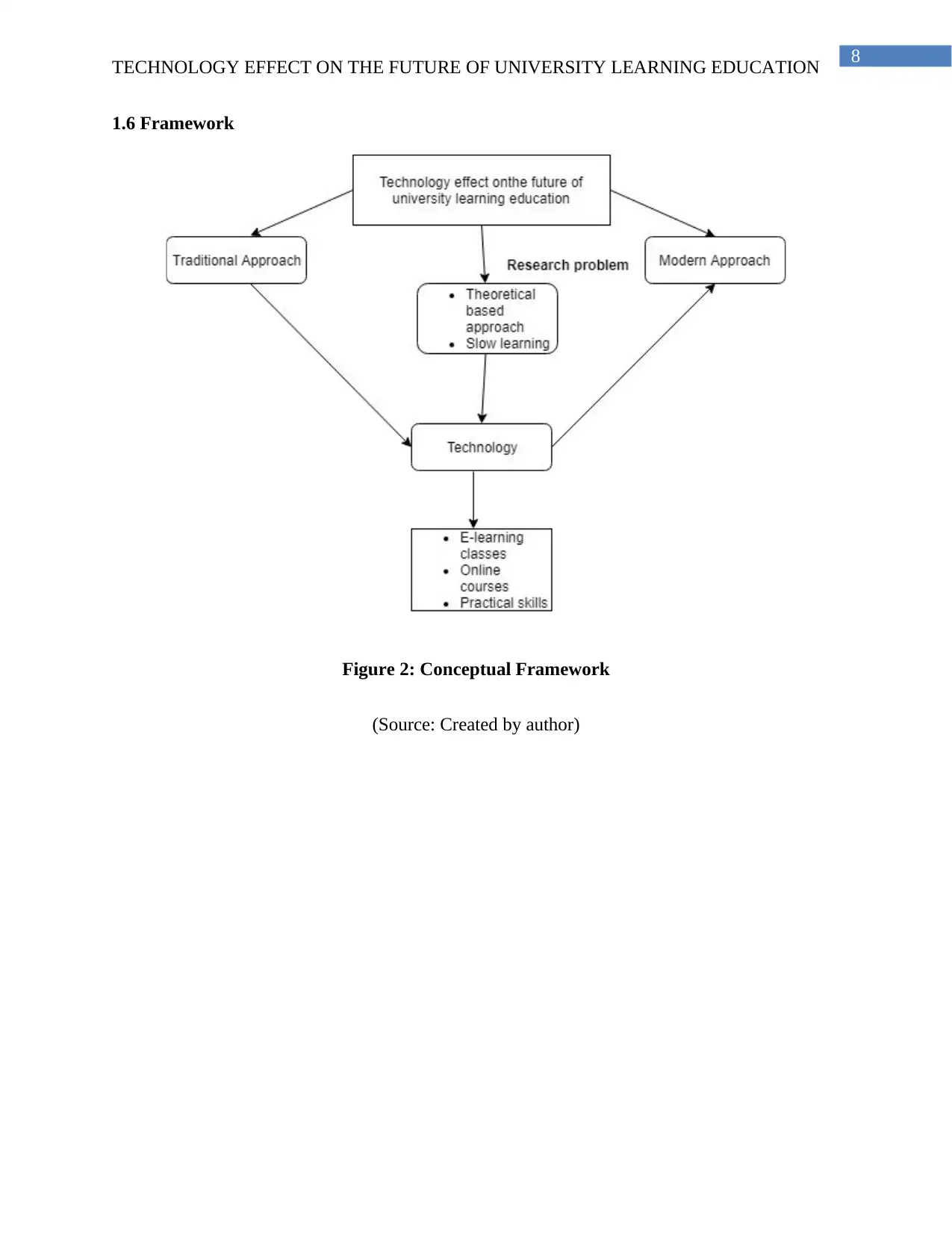
8
TECHNOLOGY EFFECT ON THE FUTURE OF UNIVERSITY LEARNING EDUCATION
1.6 Framework
Figure 2: Conceptual Framework
(Source: Created by author)
TECHNOLOGY EFFECT ON THE FUTURE OF UNIVERSITY LEARNING EDUCATION
1.6 Framework
Figure 2: Conceptual Framework
(Source: Created by author)
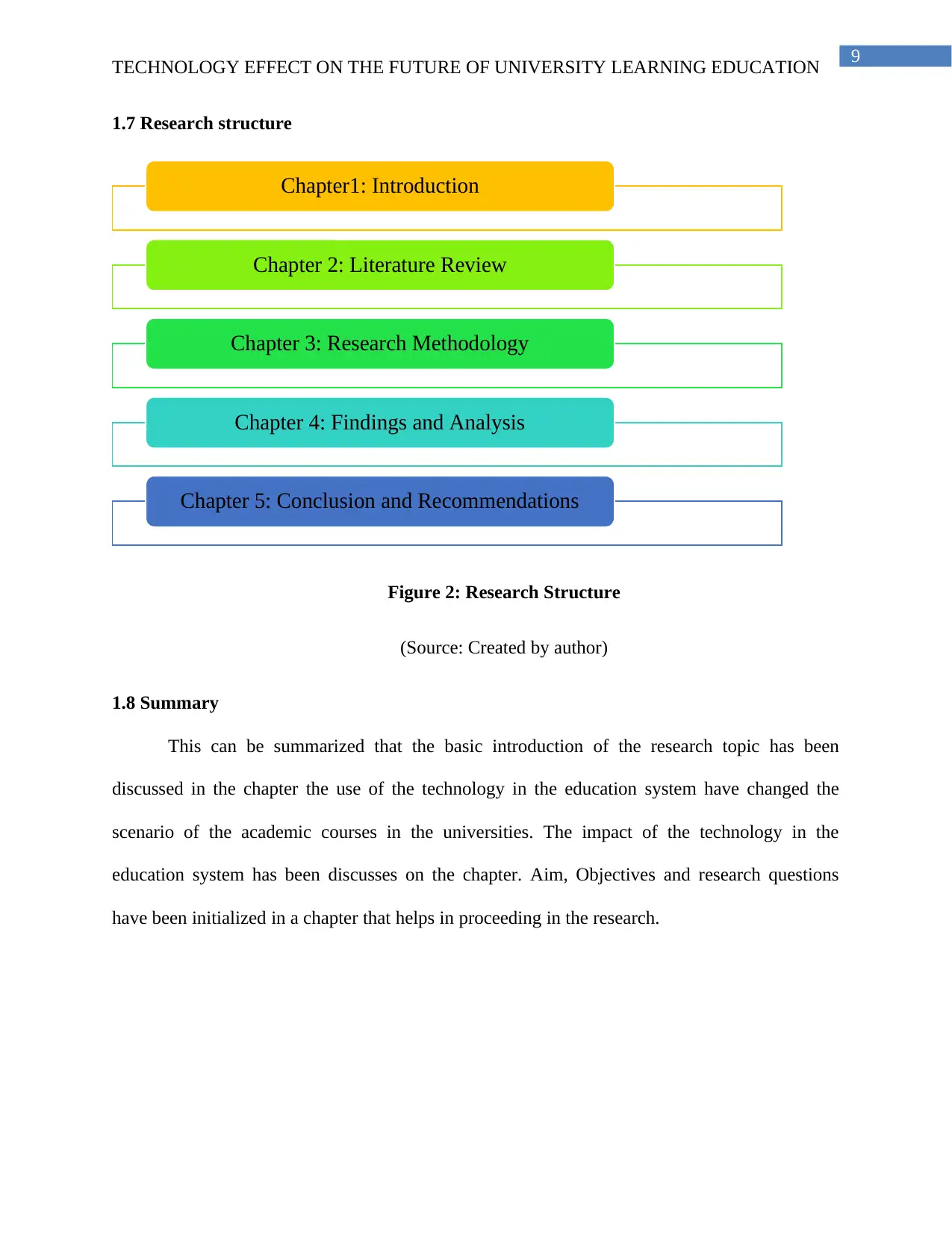
9
TECHNOLOGY EFFECT ON THE FUTURE OF UNIVERSITY LEARNING EDUCATION
1.7 Research structure
Figure 2: Research Structure
(Source: Created by author)
1.8 Summary
This can be summarized that the basic introduction of the research topic has been
discussed in the chapter the use of the technology in the education system have changed the
scenario of the academic courses in the universities. The impact of the technology in the
education system has been discusses on the chapter. Aim, Objectives and research questions
have been initialized in a chapter that helps in proceeding in the research.
Chapter1: Introduction
Chapter 2: Literature Review
Chapter 3: Research Methodology
Chapter 4: Findings and Analysis
Chapter 5: Conclusion and Recommendations
TECHNOLOGY EFFECT ON THE FUTURE OF UNIVERSITY LEARNING EDUCATION
1.7 Research structure
Figure 2: Research Structure
(Source: Created by author)
1.8 Summary
This can be summarized that the basic introduction of the research topic has been
discussed in the chapter the use of the technology in the education system have changed the
scenario of the academic courses in the universities. The impact of the technology in the
education system has been discusses on the chapter. Aim, Objectives and research questions
have been initialized in a chapter that helps in proceeding in the research.
Chapter1: Introduction
Chapter 2: Literature Review
Chapter 3: Research Methodology
Chapter 4: Findings and Analysis
Chapter 5: Conclusion and Recommendations
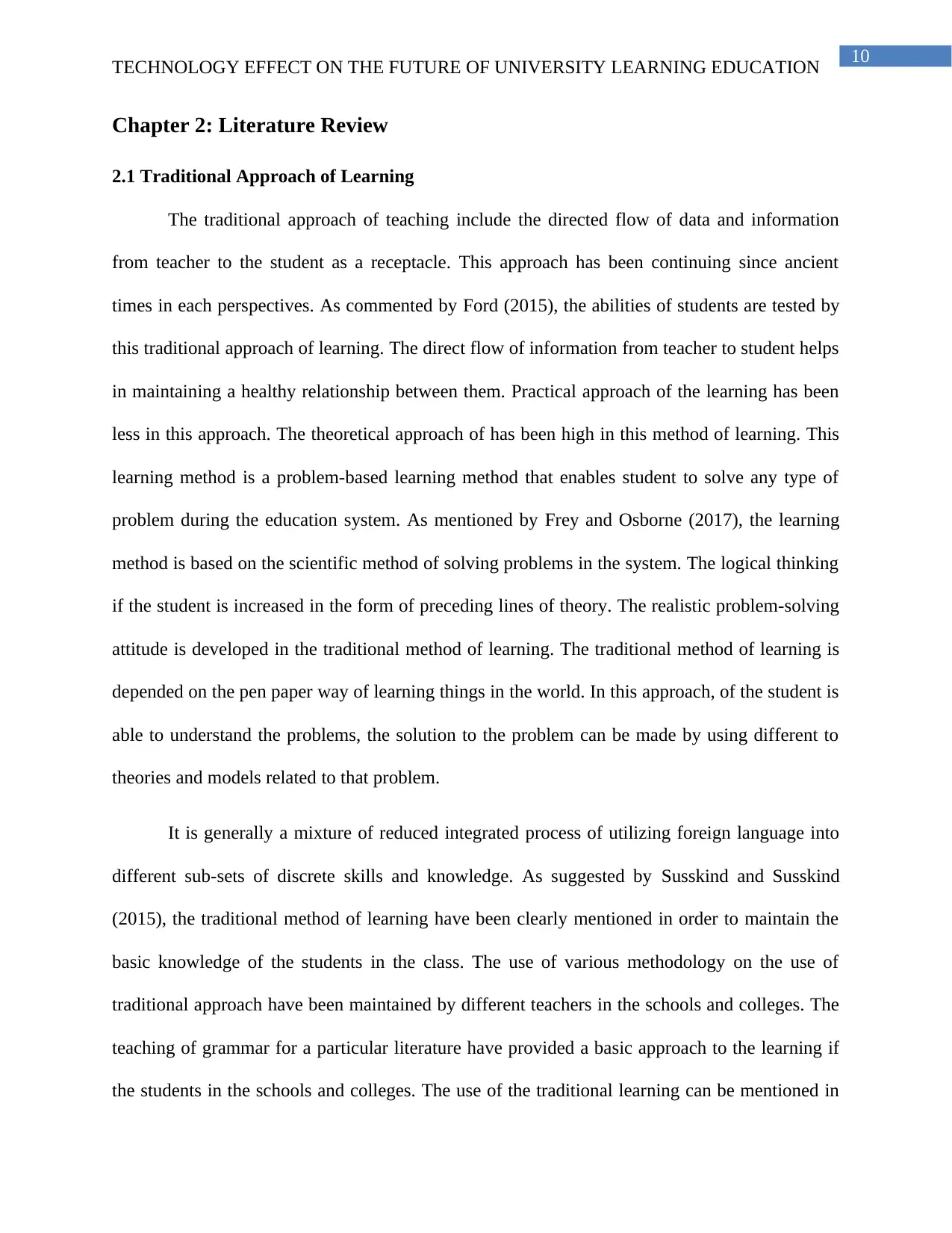
10
TECHNOLOGY EFFECT ON THE FUTURE OF UNIVERSITY LEARNING EDUCATION
Chapter 2: Literature Review
2.1 Traditional Approach of Learning
The traditional approach of teaching include the directed flow of data and information
from teacher to the student as a receptacle. This approach has been continuing since ancient
times in each perspectives. As commented by Ford (2015), the abilities of students are tested by
this traditional approach of learning. The direct flow of information from teacher to student helps
in maintaining a healthy relationship between them. Practical approach of the learning has been
less in this approach. The theoretical approach of has been high in this method of learning. This
learning method is a problem-based learning method that enables student to solve any type of
problem during the education system. As mentioned by Frey and Osborne (2017), the learning
method is based on the scientific method of solving problems in the system. The logical thinking
if the student is increased in the form of preceding lines of theory. The realistic problem-solving
attitude is developed in the traditional method of learning. The traditional method of learning is
depended on the pen paper way of learning things in the world. In this approach, of the student is
able to understand the problems, the solution to the problem can be made by using different to
theories and models related to that problem.
It is generally a mixture of reduced integrated process of utilizing foreign language into
different sub-sets of discrete skills and knowledge. As suggested by Susskind and Susskind
(2015), the traditional method of learning have been clearly mentioned in order to maintain the
basic knowledge of the students in the class. The use of various methodology on the use of
traditional approach have been maintained by different teachers in the schools and colleges. The
teaching of grammar for a particular literature have provided a basic approach to the learning if
the students in the schools and colleges. The use of the traditional learning can be mentioned in
TECHNOLOGY EFFECT ON THE FUTURE OF UNIVERSITY LEARNING EDUCATION
Chapter 2: Literature Review
2.1 Traditional Approach of Learning
The traditional approach of teaching include the directed flow of data and information
from teacher to the student as a receptacle. This approach has been continuing since ancient
times in each perspectives. As commented by Ford (2015), the abilities of students are tested by
this traditional approach of learning. The direct flow of information from teacher to student helps
in maintaining a healthy relationship between them. Practical approach of the learning has been
less in this approach. The theoretical approach of has been high in this method of learning. This
learning method is a problem-based learning method that enables student to solve any type of
problem during the education system. As mentioned by Frey and Osborne (2017), the learning
method is based on the scientific method of solving problems in the system. The logical thinking
if the student is increased in the form of preceding lines of theory. The realistic problem-solving
attitude is developed in the traditional method of learning. The traditional method of learning is
depended on the pen paper way of learning things in the world. In this approach, of the student is
able to understand the problems, the solution to the problem can be made by using different to
theories and models related to that problem.
It is generally a mixture of reduced integrated process of utilizing foreign language into
different sub-sets of discrete skills and knowledge. As suggested by Susskind and Susskind
(2015), the traditional method of learning have been clearly mentioned in order to maintain the
basic knowledge of the students in the class. The use of various methodology on the use of
traditional approach have been maintained by different teachers in the schools and colleges. The
teaching of grammar for a particular literature have provided a basic approach to the learning if
the students in the schools and colleges. The use of the traditional learning can be mentioned in
Secure Best Marks with AI Grader
Need help grading? Try our AI Grader for instant feedback on your assignments.
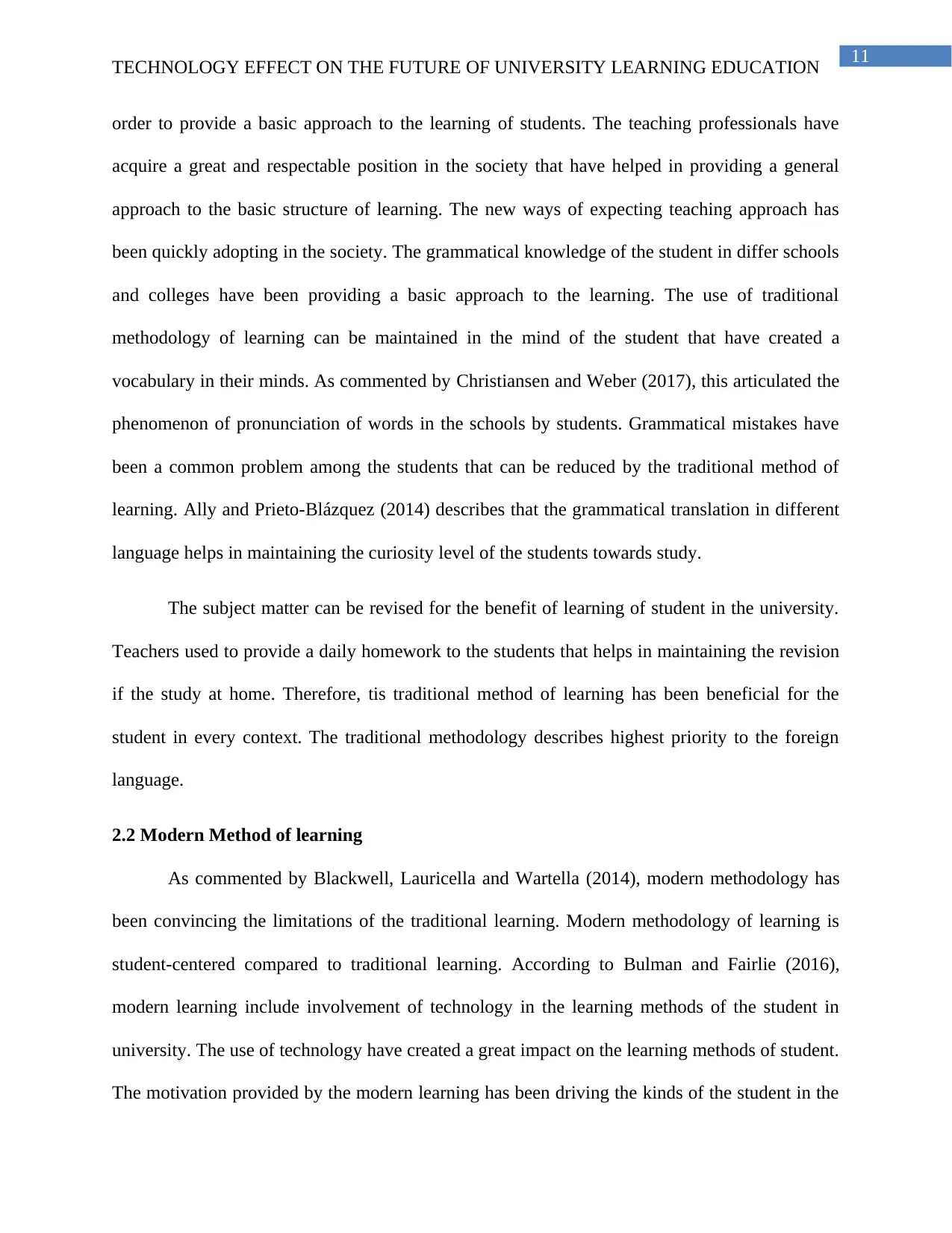
11
TECHNOLOGY EFFECT ON THE FUTURE OF UNIVERSITY LEARNING EDUCATION
order to provide a basic approach to the learning of students. The teaching professionals have
acquire a great and respectable position in the society that have helped in providing a general
approach to the basic structure of learning. The new ways of expecting teaching approach has
been quickly adopting in the society. The grammatical knowledge of the student in differ schools
and colleges have been providing a basic approach to the learning. The use of traditional
methodology of learning can be maintained in the mind of the student that have created a
vocabulary in their minds. As commented by Christiansen and Weber (2017), this articulated the
phenomenon of pronunciation of words in the schools by students. Grammatical mistakes have
been a common problem among the students that can be reduced by the traditional method of
learning. Ally and Prieto-Blázquez (2014) describes that the grammatical translation in different
language helps in maintaining the curiosity level of the students towards study.
The subject matter can be revised for the benefit of learning of student in the university.
Teachers used to provide a daily homework to the students that helps in maintaining the revision
if the study at home. Therefore, tis traditional method of learning has been beneficial for the
student in every context. The traditional methodology describes highest priority to the foreign
language.
2.2 Modern Method of learning
As commented by Blackwell, Lauricella and Wartella (2014), modern methodology has
been convincing the limitations of the traditional learning. Modern methodology of learning is
student-centered compared to traditional learning. According to Bulman and Fairlie (2016),
modern learning include involvement of technology in the learning methods of the student in
university. The use of technology have created a great impact on the learning methods of student.
The motivation provided by the modern learning has been driving the kinds of the student in the
TECHNOLOGY EFFECT ON THE FUTURE OF UNIVERSITY LEARNING EDUCATION
order to provide a basic approach to the learning of students. The teaching professionals have
acquire a great and respectable position in the society that have helped in providing a general
approach to the basic structure of learning. The new ways of expecting teaching approach has
been quickly adopting in the society. The grammatical knowledge of the student in differ schools
and colleges have been providing a basic approach to the learning. The use of traditional
methodology of learning can be maintained in the mind of the student that have created a
vocabulary in their minds. As commented by Christiansen and Weber (2017), this articulated the
phenomenon of pronunciation of words in the schools by students. Grammatical mistakes have
been a common problem among the students that can be reduced by the traditional method of
learning. Ally and Prieto-Blázquez (2014) describes that the grammatical translation in different
language helps in maintaining the curiosity level of the students towards study.
The subject matter can be revised for the benefit of learning of student in the university.
Teachers used to provide a daily homework to the students that helps in maintaining the revision
if the study at home. Therefore, tis traditional method of learning has been beneficial for the
student in every context. The traditional methodology describes highest priority to the foreign
language.
2.2 Modern Method of learning
As commented by Blackwell, Lauricella and Wartella (2014), modern methodology has
been convincing the limitations of the traditional learning. Modern methodology of learning is
student-centered compared to traditional learning. According to Bulman and Fairlie (2016),
modern learning include involvement of technology in the learning methods of the student in
university. The use of technology have created a great impact on the learning methods of student.
The motivation provided by the modern learning has been driving the kinds of the student in the
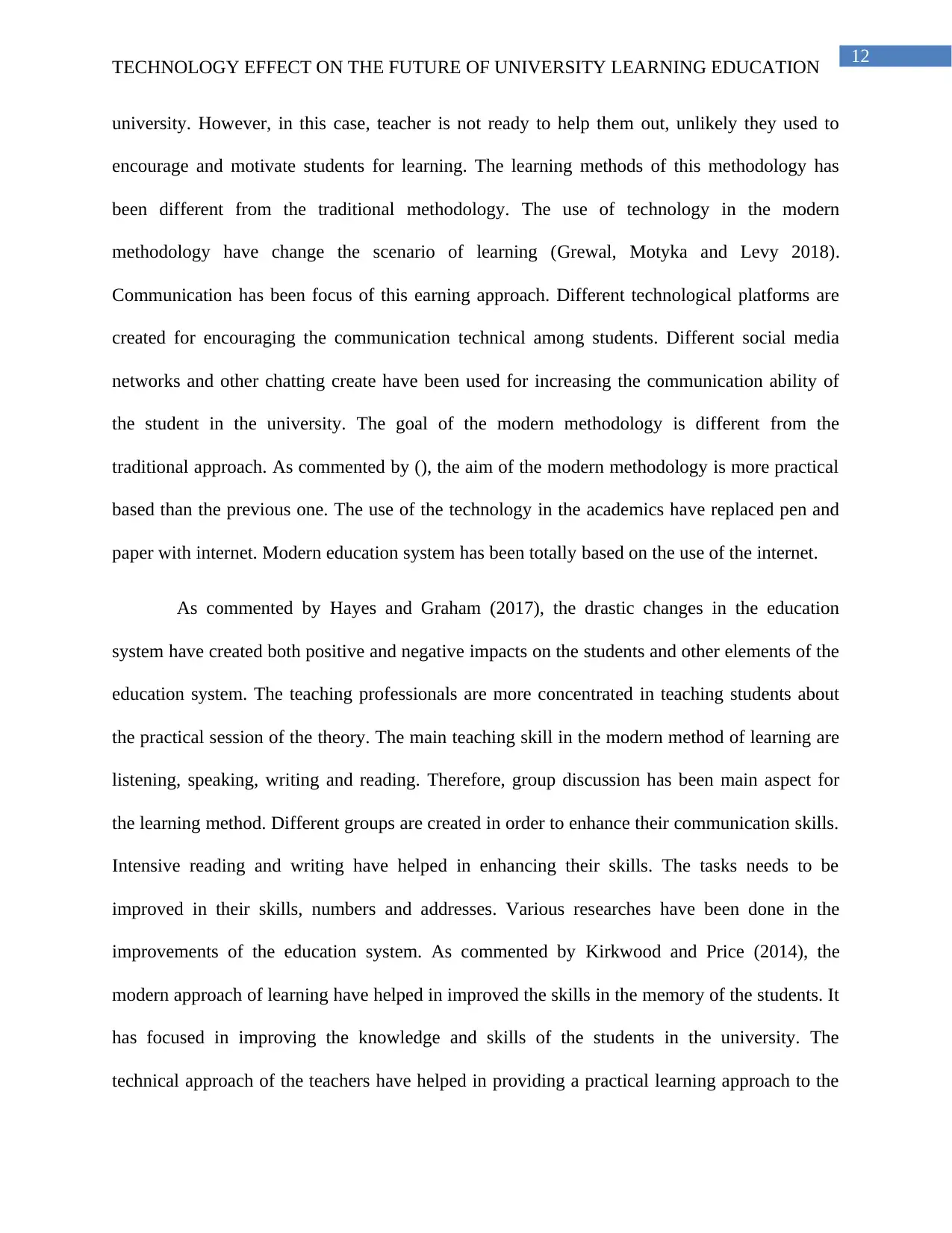
12
TECHNOLOGY EFFECT ON THE FUTURE OF UNIVERSITY LEARNING EDUCATION
university. However, in this case, teacher is not ready to help them out, unlikely they used to
encourage and motivate students for learning. The learning methods of this methodology has
been different from the traditional methodology. The use of technology in the modern
methodology have change the scenario of learning (Grewal, Motyka and Levy 2018).
Communication has been focus of this earning approach. Different technological platforms are
created for encouraging the communication technical among students. Different social media
networks and other chatting create have been used for increasing the communication ability of
the student in the university. The goal of the modern methodology is different from the
traditional approach. As commented by (), the aim of the modern methodology is more practical
based than the previous one. The use of the technology in the academics have replaced pen and
paper with internet. Modern education system has been totally based on the use of the internet.
As commented by Hayes and Graham (2017), the drastic changes in the education
system have created both positive and negative impacts on the students and other elements of the
education system. The teaching professionals are more concentrated in teaching students about
the practical session of the theory. The main teaching skill in the modern method of learning are
listening, speaking, writing and reading. Therefore, group discussion has been main aspect for
the learning method. Different groups are created in order to enhance their communication skills.
Intensive reading and writing have helped in enhancing their skills. The tasks needs to be
improved in their skills, numbers and addresses. Various researches have been done in the
improvements of the education system. As commented by Kirkwood and Price (2014), the
modern approach of learning have helped in improved the skills in the memory of the students. It
has focused in improving the knowledge and skills of the students in the university. The
technical approach of the teachers have helped in providing a practical learning approach to the
TECHNOLOGY EFFECT ON THE FUTURE OF UNIVERSITY LEARNING EDUCATION
university. However, in this case, teacher is not ready to help them out, unlikely they used to
encourage and motivate students for learning. The learning methods of this methodology has
been different from the traditional methodology. The use of technology in the modern
methodology have change the scenario of learning (Grewal, Motyka and Levy 2018).
Communication has been focus of this earning approach. Different technological platforms are
created for encouraging the communication technical among students. Different social media
networks and other chatting create have been used for increasing the communication ability of
the student in the university. The goal of the modern methodology is different from the
traditional approach. As commented by (), the aim of the modern methodology is more practical
based than the previous one. The use of the technology in the academics have replaced pen and
paper with internet. Modern education system has been totally based on the use of the internet.
As commented by Hayes and Graham (2017), the drastic changes in the education
system have created both positive and negative impacts on the students and other elements of the
education system. The teaching professionals are more concentrated in teaching students about
the practical session of the theory. The main teaching skill in the modern method of learning are
listening, speaking, writing and reading. Therefore, group discussion has been main aspect for
the learning method. Different groups are created in order to enhance their communication skills.
Intensive reading and writing have helped in enhancing their skills. The tasks needs to be
improved in their skills, numbers and addresses. Various researches have been done in the
improvements of the education system. As commented by Kirkwood and Price (2014), the
modern approach of learning have helped in improved the skills in the memory of the students. It
has focused in improving the knowledge and skills of the students in the university. The
technical approach of the teachers have helped in providing a practical learning approach to the

13
TECHNOLOGY EFFECT ON THE FUTURE OF UNIVERSITY LEARNING EDUCATION
students. The IT experiences in the learning system have helped in providing a better approach to
the learning skills of the students in the university. The use of various technical gadgets
including smart phones, e-dictionary have helped in enhancing the technical knowledge of
students in the university.
2.3 Impact of technology in future learning education
The technology have drastically affected the learning procedure of the students in various
universities and other learning institutions. The use of various technical procedures including
projectors, online e-learning and online classes have helped in providing high quality education
ot students. As mentioned by Cheng et al. (2014), technical learning include various advanced
methodologies that help in providing quality learning to students. Online classes have helped in
providing classes over the internet to the students at home. Students can attend their lectures over
the internet at home. Therefore, this have helped in minimizing extra time for travelling and
other wastages. Students can concentrate in their studies at home. The footprint of the
professionals can be learned over the internet. The emergence of new technologies have created
a space for the learning methods at universities. New technologies have been created new smart
goals and objectives for the students in order to gather knowledge and enhance their skills. As
commented by Stromquist and Monkman (2014), a practical approach has been followed by this
technological approach of learning, the technical environment in the schools and colleges have
created motivation among the students. Various new technologies including Web 2.0 and digital
classroom have helped in connecting students to the technical aspect of learning (Bernard et al.
2014). Digital games have helped in increasing the analytical thinking of students. Modern
games are highly modifies by graphical and strategy that helped in enhancing the thinking power
of the student. The civilization of the human being have been changing with the implementation
TECHNOLOGY EFFECT ON THE FUTURE OF UNIVERSITY LEARNING EDUCATION
students. The IT experiences in the learning system have helped in providing a better approach to
the learning skills of the students in the university. The use of various technical gadgets
including smart phones, e-dictionary have helped in enhancing the technical knowledge of
students in the university.
2.3 Impact of technology in future learning education
The technology have drastically affected the learning procedure of the students in various
universities and other learning institutions. The use of various technical procedures including
projectors, online e-learning and online classes have helped in providing high quality education
ot students. As mentioned by Cheng et al. (2014), technical learning include various advanced
methodologies that help in providing quality learning to students. Online classes have helped in
providing classes over the internet to the students at home. Students can attend their lectures over
the internet at home. Therefore, this have helped in minimizing extra time for travelling and
other wastages. Students can concentrate in their studies at home. The footprint of the
professionals can be learned over the internet. The emergence of new technologies have created
a space for the learning methods at universities. New technologies have been created new smart
goals and objectives for the students in order to gather knowledge and enhance their skills. As
commented by Stromquist and Monkman (2014), a practical approach has been followed by this
technological approach of learning, the technical environment in the schools and colleges have
created motivation among the students. Various new technologies including Web 2.0 and digital
classroom have helped in connecting students to the technical aspect of learning (Bernard et al.
2014). Digital games have helped in increasing the analytical thinking of students. Modern
games are highly modifies by graphical and strategy that helped in enhancing the thinking power
of the student. The civilization of the human being have been changing with the implementation
Paraphrase This Document
Need a fresh take? Get an instant paraphrase of this document with our AI Paraphraser
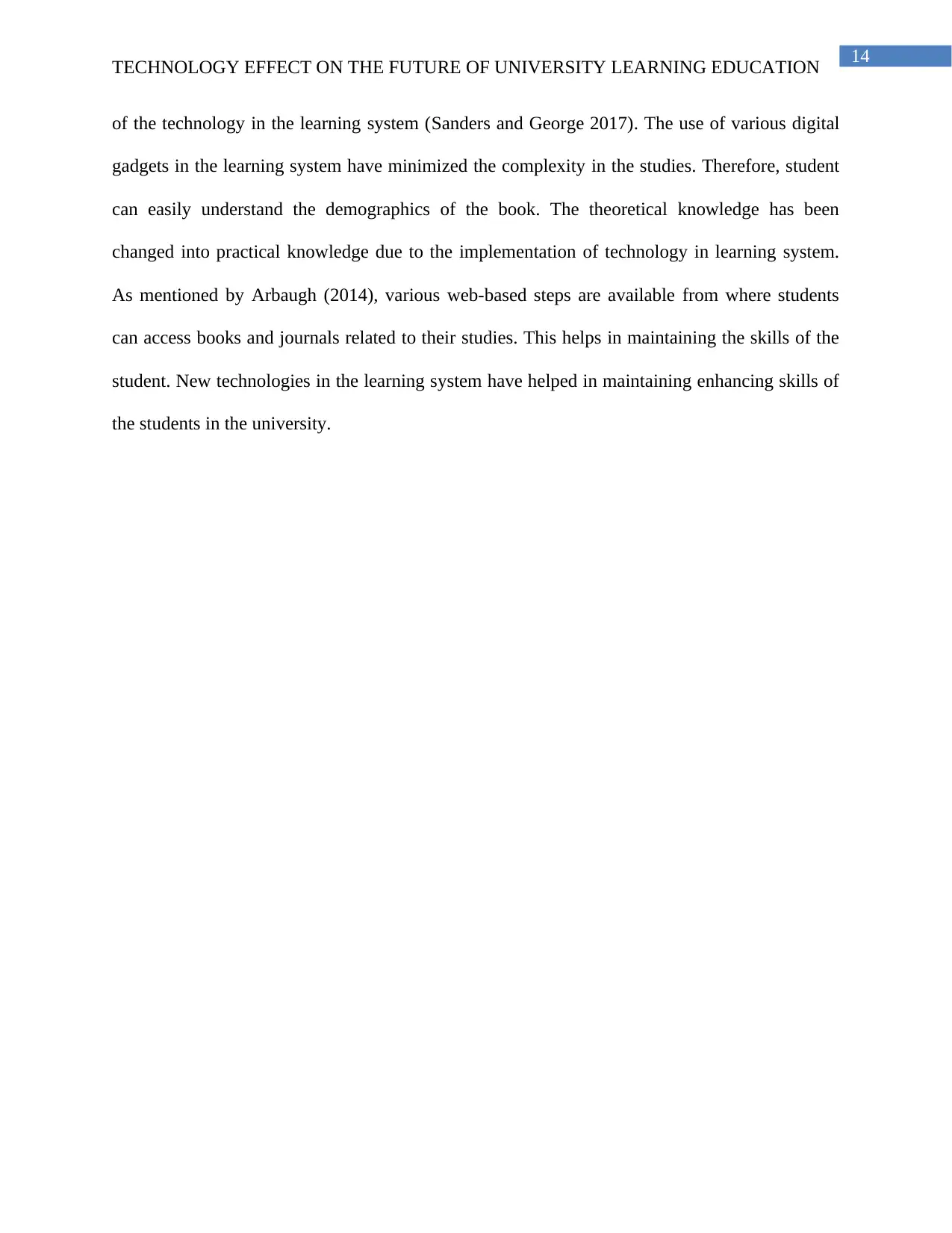
14
TECHNOLOGY EFFECT ON THE FUTURE OF UNIVERSITY LEARNING EDUCATION
of the technology in the learning system (Sanders and George 2017). The use of various digital
gadgets in the learning system have minimized the complexity in the studies. Therefore, student
can easily understand the demographics of the book. The theoretical knowledge has been
changed into practical knowledge due to the implementation of technology in learning system.
As mentioned by Arbaugh (2014), various web-based steps are available from where students
can access books and journals related to their studies. This helps in maintaining the skills of the
student. New technologies in the learning system have helped in maintaining enhancing skills of
the students in the university.
TECHNOLOGY EFFECT ON THE FUTURE OF UNIVERSITY LEARNING EDUCATION
of the technology in the learning system (Sanders and George 2017). The use of various digital
gadgets in the learning system have minimized the complexity in the studies. Therefore, student
can easily understand the demographics of the book. The theoretical knowledge has been
changed into practical knowledge due to the implementation of technology in learning system.
As mentioned by Arbaugh (2014), various web-based steps are available from where students
can access books and journals related to their studies. This helps in maintaining the skills of the
student. New technologies in the learning system have helped in maintaining enhancing skills of
the students in the university.
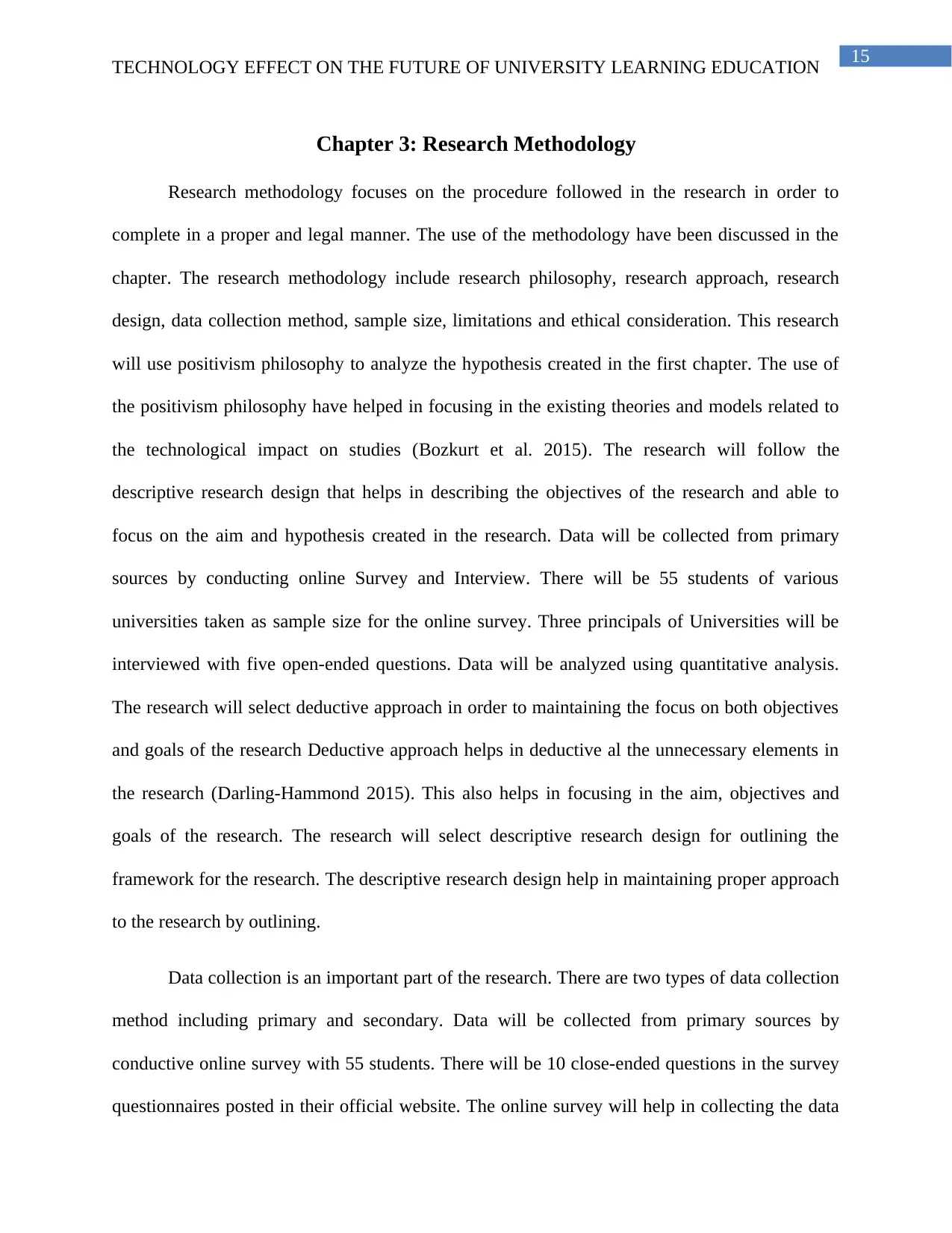
15
TECHNOLOGY EFFECT ON THE FUTURE OF UNIVERSITY LEARNING EDUCATION
Chapter 3: Research Methodology
Research methodology focuses on the procedure followed in the research in order to
complete in a proper and legal manner. The use of the methodology have been discussed in the
chapter. The research methodology include research philosophy, research approach, research
design, data collection method, sample size, limitations and ethical consideration. This research
will use positivism philosophy to analyze the hypothesis created in the first chapter. The use of
the positivism philosophy have helped in focusing in the existing theories and models related to
the technological impact on studies (Bozkurt et al. 2015). The research will follow the
descriptive research design that helps in describing the objectives of the research and able to
focus on the aim and hypothesis created in the research. Data will be collected from primary
sources by conducting online Survey and Interview. There will be 55 students of various
universities taken as sample size for the online survey. Three principals of Universities will be
interviewed with five open-ended questions. Data will be analyzed using quantitative analysis.
The research will select deductive approach in order to maintaining the focus on both objectives
and goals of the research Deductive approach helps in deductive al the unnecessary elements in
the research (Darling-Hammond 2015). This also helps in focusing in the aim, objectives and
goals of the research. The research will select descriptive research design for outlining the
framework for the research. The descriptive research design help in maintaining proper approach
to the research by outlining.
Data collection is an important part of the research. There are two types of data collection
method including primary and secondary. Data will be collected from primary sources by
conductive online survey with 55 students. There will be 10 close-ended questions in the survey
questionnaires posted in their official website. The online survey will help in collecting the data
TECHNOLOGY EFFECT ON THE FUTURE OF UNIVERSITY LEARNING EDUCATION
Chapter 3: Research Methodology
Research methodology focuses on the procedure followed in the research in order to
complete in a proper and legal manner. The use of the methodology have been discussed in the
chapter. The research methodology include research philosophy, research approach, research
design, data collection method, sample size, limitations and ethical consideration. This research
will use positivism philosophy to analyze the hypothesis created in the first chapter. The use of
the positivism philosophy have helped in focusing in the existing theories and models related to
the technological impact on studies (Bozkurt et al. 2015). The research will follow the
descriptive research design that helps in describing the objectives of the research and able to
focus on the aim and hypothesis created in the research. Data will be collected from primary
sources by conducting online Survey and Interview. There will be 55 students of various
universities taken as sample size for the online survey. Three principals of Universities will be
interviewed with five open-ended questions. Data will be analyzed using quantitative analysis.
The research will select deductive approach in order to maintaining the focus on both objectives
and goals of the research Deductive approach helps in deductive al the unnecessary elements in
the research (Darling-Hammond 2015). This also helps in focusing in the aim, objectives and
goals of the research. The research will select descriptive research design for outlining the
framework for the research. The descriptive research design help in maintaining proper approach
to the research by outlining.
Data collection is an important part of the research. There are two types of data collection
method including primary and secondary. Data will be collected from primary sources by
conductive online survey with 55 students. There will be 10 close-ended questions in the survey
questionnaires posted in their official website. The online survey will help in collecting the data
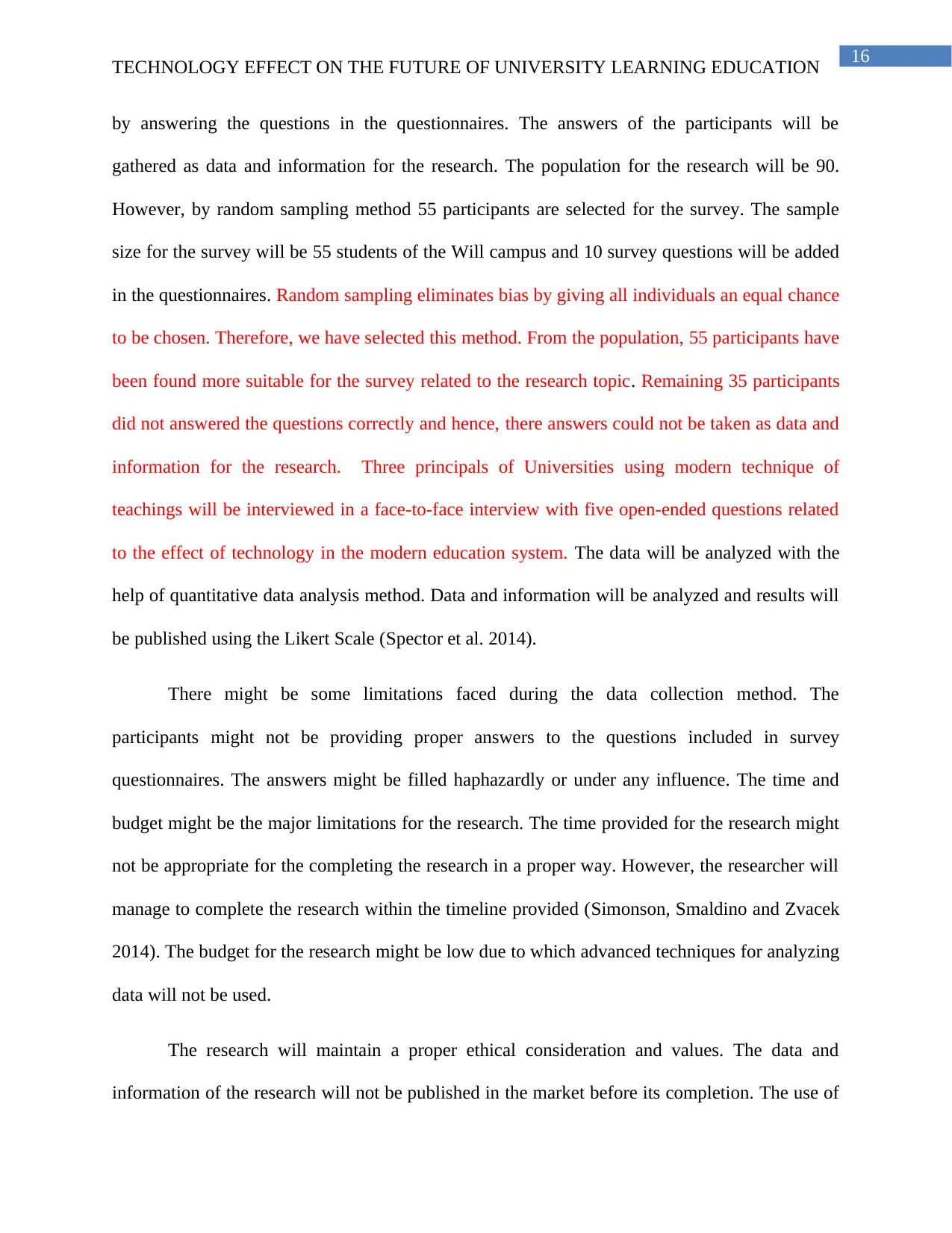
16
TECHNOLOGY EFFECT ON THE FUTURE OF UNIVERSITY LEARNING EDUCATION
by answering the questions in the questionnaires. The answers of the participants will be
gathered as data and information for the research. The population for the research will be 90.
However, by random sampling method 55 participants are selected for the survey. The sample
size for the survey will be 55 students of the Will campus and 10 survey questions will be added
in the questionnaires. Random sampling eliminates bias by giving all individuals an equal chance
to be chosen. Therefore, we have selected this method. From the population, 55 participants have
been found more suitable for the survey related to the research topic. Remaining 35 participants
did not answered the questions correctly and hence, there answers could not be taken as data and
information for the research. Three principals of Universities using modern technique of
teachings will be interviewed in a face-to-face interview with five open-ended questions related
to the effect of technology in the modern education system. The data will be analyzed with the
help of quantitative data analysis method. Data and information will be analyzed and results will
be published using the Likert Scale (Spector et al. 2014).
There might be some limitations faced during the data collection method. The
participants might not be providing proper answers to the questions included in survey
questionnaires. The answers might be filled haphazardly or under any influence. The time and
budget might be the major limitations for the research. The time provided for the research might
not be appropriate for the completing the research in a proper way. However, the researcher will
manage to complete the research within the timeline provided (Simonson, Smaldino and Zvacek
2014). The budget for the research might be low due to which advanced techniques for analyzing
data will not be used.
The research will maintain a proper ethical consideration and values. The data and
information of the research will not be published in the market before its completion. The use of
TECHNOLOGY EFFECT ON THE FUTURE OF UNIVERSITY LEARNING EDUCATION
by answering the questions in the questionnaires. The answers of the participants will be
gathered as data and information for the research. The population for the research will be 90.
However, by random sampling method 55 participants are selected for the survey. The sample
size for the survey will be 55 students of the Will campus and 10 survey questions will be added
in the questionnaires. Random sampling eliminates bias by giving all individuals an equal chance
to be chosen. Therefore, we have selected this method. From the population, 55 participants have
been found more suitable for the survey related to the research topic. Remaining 35 participants
did not answered the questions correctly and hence, there answers could not be taken as data and
information for the research. Three principals of Universities using modern technique of
teachings will be interviewed in a face-to-face interview with five open-ended questions related
to the effect of technology in the modern education system. The data will be analyzed with the
help of quantitative data analysis method. Data and information will be analyzed and results will
be published using the Likert Scale (Spector et al. 2014).
There might be some limitations faced during the data collection method. The
participants might not be providing proper answers to the questions included in survey
questionnaires. The answers might be filled haphazardly or under any influence. The time and
budget might be the major limitations for the research. The time provided for the research might
not be appropriate for the completing the research in a proper way. However, the researcher will
manage to complete the research within the timeline provided (Simonson, Smaldino and Zvacek
2014). The budget for the research might be low due to which advanced techniques for analyzing
data will not be used.
The research will maintain a proper ethical consideration and values. The data and
information of the research will not be published in the market before its completion. The use of
Secure Best Marks with AI Grader
Need help grading? Try our AI Grader for instant feedback on your assignments.
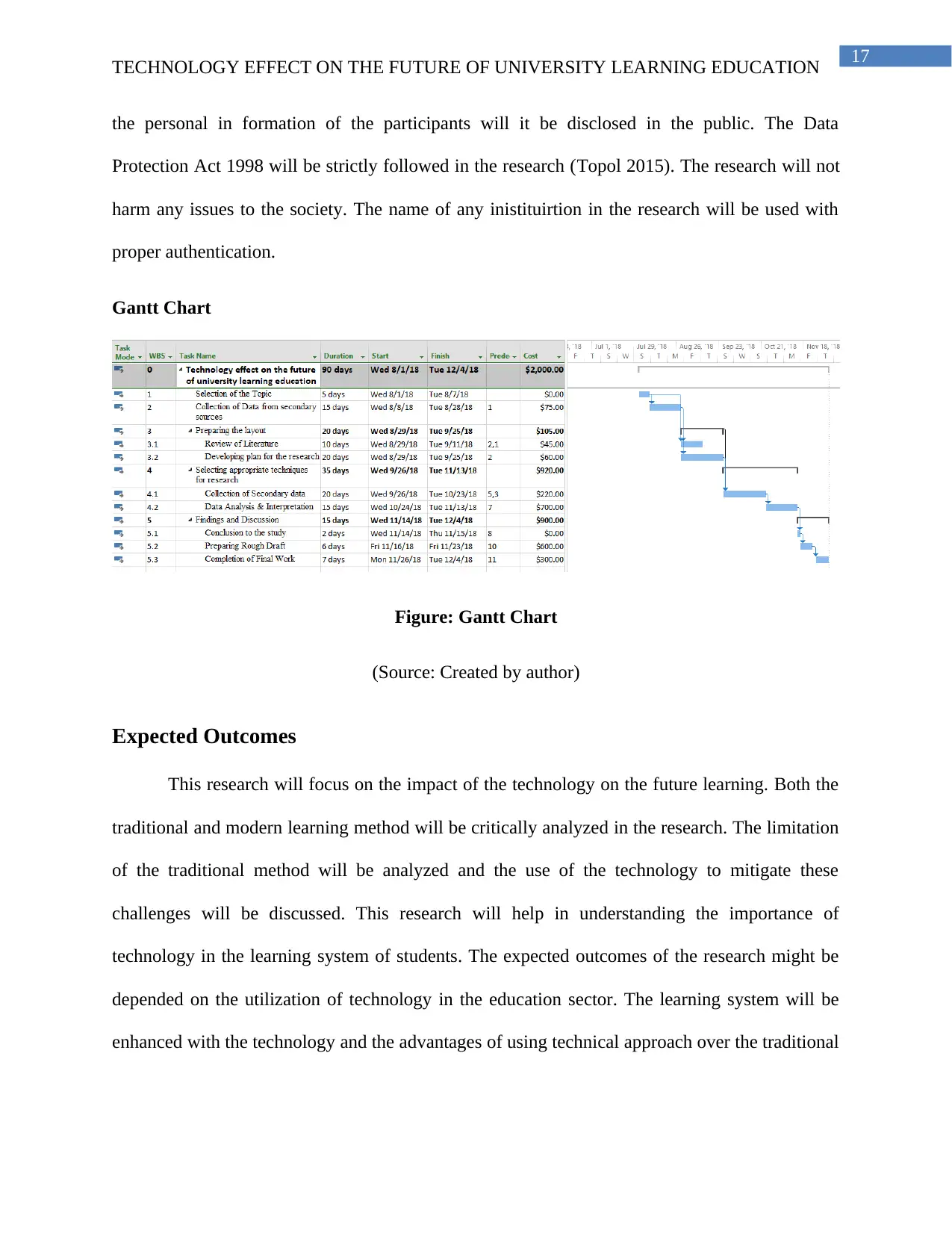
17
TECHNOLOGY EFFECT ON THE FUTURE OF UNIVERSITY LEARNING EDUCATION
the personal in formation of the participants will it be disclosed in the public. The Data
Protection Act 1998 will be strictly followed in the research (Topol 2015). The research will not
harm any issues to the society. The name of any inistituirtion in the research will be used with
proper authentication.
Gantt Chart
Figure: Gantt Chart
(Source: Created by author)
Expected Outcomes
This research will focus on the impact of the technology on the future learning. Both the
traditional and modern learning method will be critically analyzed in the research. The limitation
of the traditional method will be analyzed and the use of the technology to mitigate these
challenges will be discussed. This research will help in understanding the importance of
technology in the learning system of students. The expected outcomes of the research might be
depended on the utilization of technology in the education sector. The learning system will be
enhanced with the technology and the advantages of using technical approach over the traditional
TECHNOLOGY EFFECT ON THE FUTURE OF UNIVERSITY LEARNING EDUCATION
the personal in formation of the participants will it be disclosed in the public. The Data
Protection Act 1998 will be strictly followed in the research (Topol 2015). The research will not
harm any issues to the society. The name of any inistituirtion in the research will be used with
proper authentication.
Gantt Chart
Figure: Gantt Chart
(Source: Created by author)
Expected Outcomes
This research will focus on the impact of the technology on the future learning. Both the
traditional and modern learning method will be critically analyzed in the research. The limitation
of the traditional method will be analyzed and the use of the technology to mitigate these
challenges will be discussed. This research will help in understanding the importance of
technology in the learning system of students. The expected outcomes of the research might be
depended on the utilization of technology in the education sector. The learning system will be
enhanced with the technology and the advantages of using technical approach over the traditional
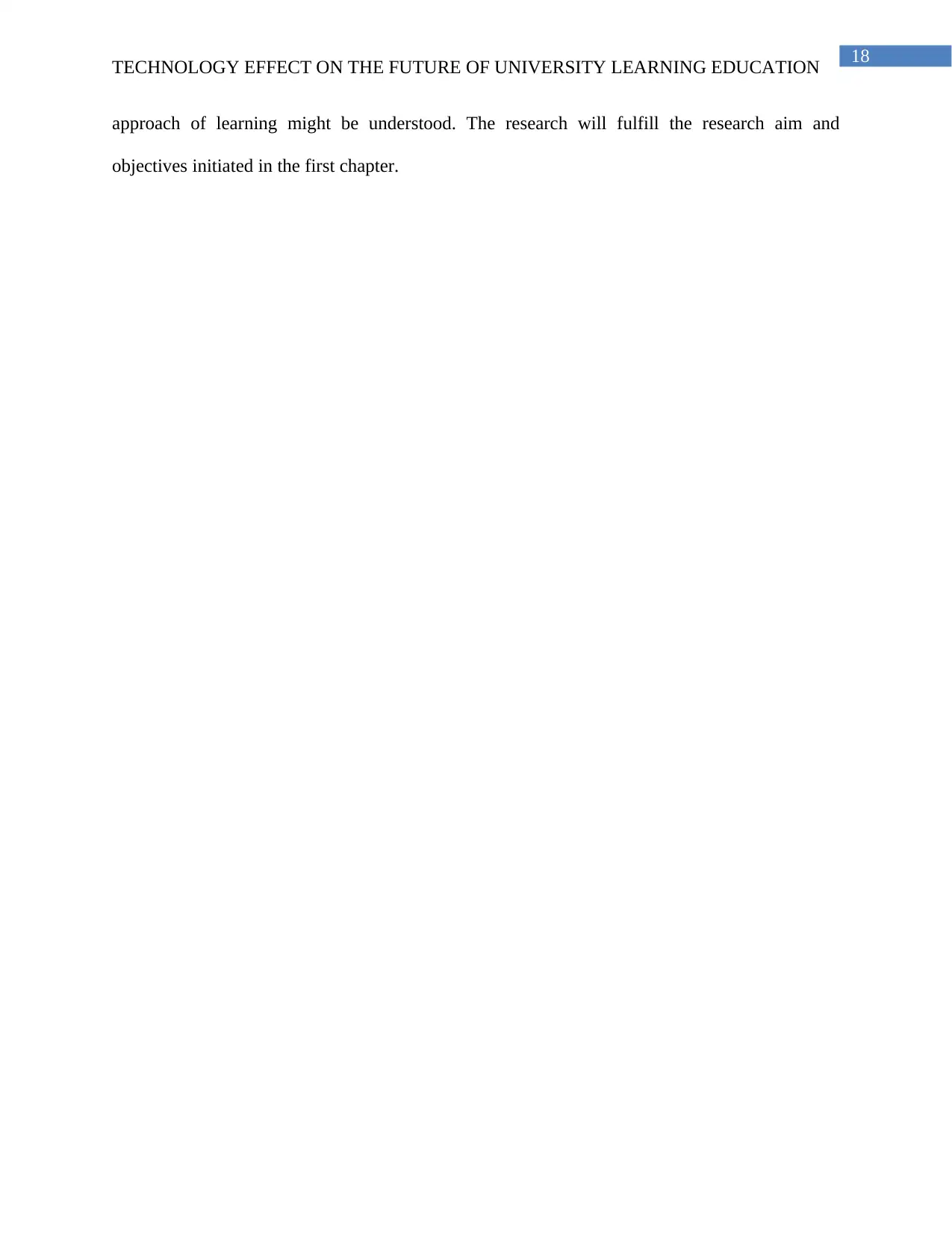
18
TECHNOLOGY EFFECT ON THE FUTURE OF UNIVERSITY LEARNING EDUCATION
approach of learning might be understood. The research will fulfill the research aim and
objectives initiated in the first chapter.
TECHNOLOGY EFFECT ON THE FUTURE OF UNIVERSITY LEARNING EDUCATION
approach of learning might be understood. The research will fulfill the research aim and
objectives initiated in the first chapter.
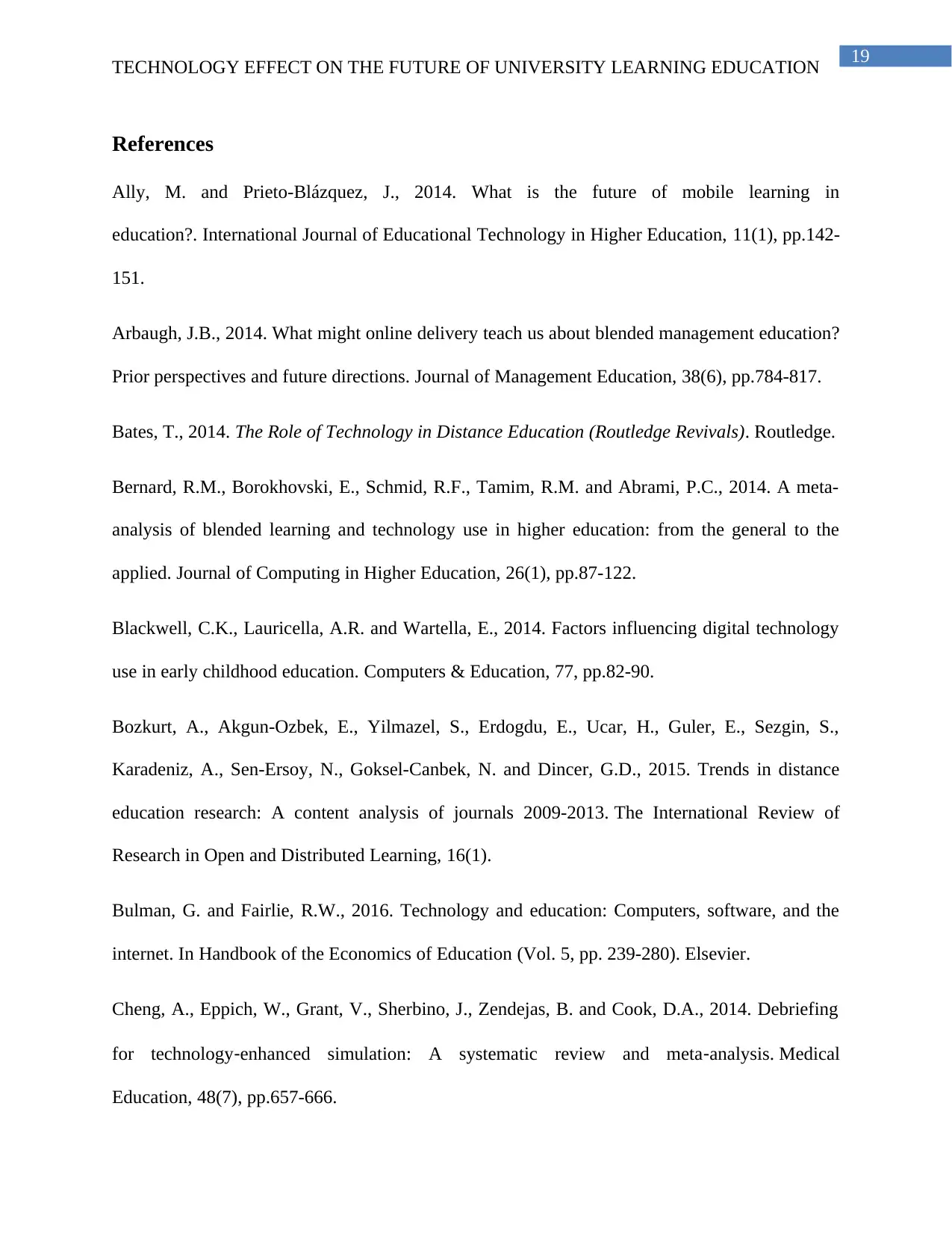
19
TECHNOLOGY EFFECT ON THE FUTURE OF UNIVERSITY LEARNING EDUCATION
References
Ally, M. and Prieto-Blázquez, J., 2014. What is the future of mobile learning in
education?. International Journal of Educational Technology in Higher Education, 11(1), pp.142-
151.
Arbaugh, J.B., 2014. What might online delivery teach us about blended management education?
Prior perspectives and future directions. Journal of Management Education, 38(6), pp.784-817.
Bates, T., 2014. The Role of Technology in Distance Education (Routledge Revivals). Routledge.
Bernard, R.M., Borokhovski, E., Schmid, R.F., Tamim, R.M. and Abrami, P.C., 2014. A meta-
analysis of blended learning and technology use in higher education: from the general to the
applied. Journal of Computing in Higher Education, 26(1), pp.87-122.
Blackwell, C.K., Lauricella, A.R. and Wartella, E., 2014. Factors influencing digital technology
use in early childhood education. Computers & Education, 77, pp.82-90.
Bozkurt, A., Akgun-Ozbek, E., Yilmazel, S., Erdogdu, E., Ucar, H., Guler, E., Sezgin, S.,
Karadeniz, A., Sen-Ersoy, N., Goksel-Canbek, N. and Dincer, G.D., 2015. Trends in distance
education research: A content analysis of journals 2009-2013. The International Review of
Research in Open and Distributed Learning, 16(1).
Bulman, G. and Fairlie, R.W., 2016. Technology and education: Computers, software, and the
internet. In Handbook of the Economics of Education (Vol. 5, pp. 239-280). Elsevier.
Cheng, A., Eppich, W., Grant, V., Sherbino, J., Zendejas, B. and Cook, D.A., 2014. Debriefing
for technology‐enhanced simulation: A systematic review and meta‐analysis. Medical
Education, 48(7), pp.657-666.
TECHNOLOGY EFFECT ON THE FUTURE OF UNIVERSITY LEARNING EDUCATION
References
Ally, M. and Prieto-Blázquez, J., 2014. What is the future of mobile learning in
education?. International Journal of Educational Technology in Higher Education, 11(1), pp.142-
151.
Arbaugh, J.B., 2014. What might online delivery teach us about blended management education?
Prior perspectives and future directions. Journal of Management Education, 38(6), pp.784-817.
Bates, T., 2014. The Role of Technology in Distance Education (Routledge Revivals). Routledge.
Bernard, R.M., Borokhovski, E., Schmid, R.F., Tamim, R.M. and Abrami, P.C., 2014. A meta-
analysis of blended learning and technology use in higher education: from the general to the
applied. Journal of Computing in Higher Education, 26(1), pp.87-122.
Blackwell, C.K., Lauricella, A.R. and Wartella, E., 2014. Factors influencing digital technology
use in early childhood education. Computers & Education, 77, pp.82-90.
Bozkurt, A., Akgun-Ozbek, E., Yilmazel, S., Erdogdu, E., Ucar, H., Guler, E., Sezgin, S.,
Karadeniz, A., Sen-Ersoy, N., Goksel-Canbek, N. and Dincer, G.D., 2015. Trends in distance
education research: A content analysis of journals 2009-2013. The International Review of
Research in Open and Distributed Learning, 16(1).
Bulman, G. and Fairlie, R.W., 2016. Technology and education: Computers, software, and the
internet. In Handbook of the Economics of Education (Vol. 5, pp. 239-280). Elsevier.
Cheng, A., Eppich, W., Grant, V., Sherbino, J., Zendejas, B. and Cook, D.A., 2014. Debriefing
for technology‐enhanced simulation: A systematic review and meta‐analysis. Medical
Education, 48(7), pp.657-666.
Paraphrase This Document
Need a fresh take? Get an instant paraphrase of this document with our AI Paraphraser
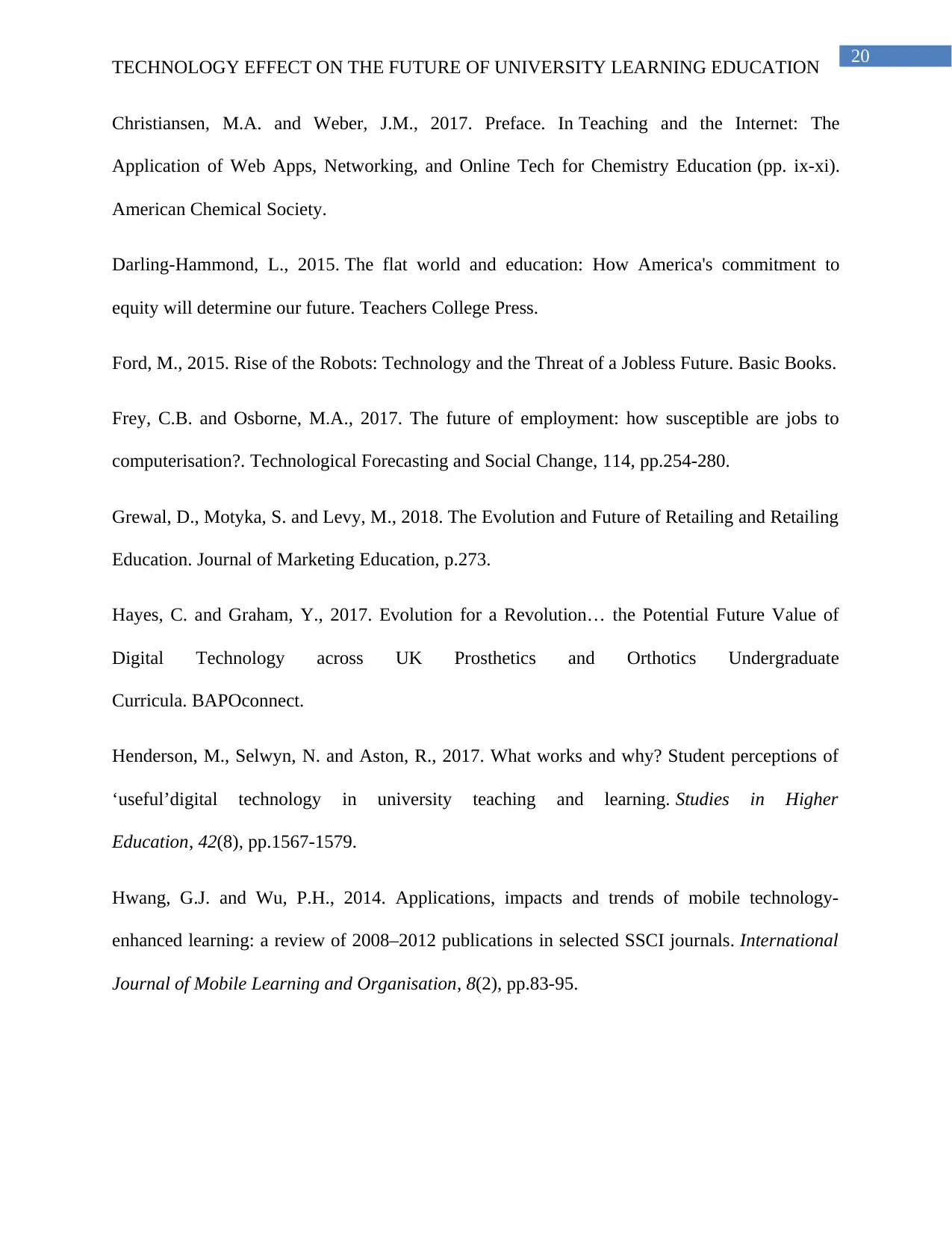
20
TECHNOLOGY EFFECT ON THE FUTURE OF UNIVERSITY LEARNING EDUCATION
Christiansen, M.A. and Weber, J.M., 2017. Preface. In Teaching and the Internet: The
Application of Web Apps, Networking, and Online Tech for Chemistry Education (pp. ix-xi).
American Chemical Society.
Darling-Hammond, L., 2015. The flat world and education: How America's commitment to
equity will determine our future. Teachers College Press.
Ford, M., 2015. Rise of the Robots: Technology and the Threat of a Jobless Future. Basic Books.
Frey, C.B. and Osborne, M.A., 2017. The future of employment: how susceptible are jobs to
computerisation?. Technological Forecasting and Social Change, 114, pp.254-280.
Grewal, D., Motyka, S. and Levy, M., 2018. The Evolution and Future of Retailing and Retailing
Education. Journal of Marketing Education, p.273.
Hayes, C. and Graham, Y., 2017. Evolution for a Revolution… the Potential Future Value of
Digital Technology across UK Prosthetics and Orthotics Undergraduate
Curricula. BAPOconnect.
Henderson, M., Selwyn, N. and Aston, R., 2017. What works and why? Student perceptions of
‘useful’digital technology in university teaching and learning. Studies in Higher
Education, 42(8), pp.1567-1579.
Hwang, G.J. and Wu, P.H., 2014. Applications, impacts and trends of mobile technology-
enhanced learning: a review of 2008–2012 publications in selected SSCI journals. International
Journal of Mobile Learning and Organisation, 8(2), pp.83-95.
TECHNOLOGY EFFECT ON THE FUTURE OF UNIVERSITY LEARNING EDUCATION
Christiansen, M.A. and Weber, J.M., 2017. Preface. In Teaching and the Internet: The
Application of Web Apps, Networking, and Online Tech for Chemistry Education (pp. ix-xi).
American Chemical Society.
Darling-Hammond, L., 2015. The flat world and education: How America's commitment to
equity will determine our future. Teachers College Press.
Ford, M., 2015. Rise of the Robots: Technology and the Threat of a Jobless Future. Basic Books.
Frey, C.B. and Osborne, M.A., 2017. The future of employment: how susceptible are jobs to
computerisation?. Technological Forecasting and Social Change, 114, pp.254-280.
Grewal, D., Motyka, S. and Levy, M., 2018. The Evolution and Future of Retailing and Retailing
Education. Journal of Marketing Education, p.273.
Hayes, C. and Graham, Y., 2017. Evolution for a Revolution… the Potential Future Value of
Digital Technology across UK Prosthetics and Orthotics Undergraduate
Curricula. BAPOconnect.
Henderson, M., Selwyn, N. and Aston, R., 2017. What works and why? Student perceptions of
‘useful’digital technology in university teaching and learning. Studies in Higher
Education, 42(8), pp.1567-1579.
Hwang, G.J. and Wu, P.H., 2014. Applications, impacts and trends of mobile technology-
enhanced learning: a review of 2008–2012 publications in selected SSCI journals. International
Journal of Mobile Learning and Organisation, 8(2), pp.83-95.
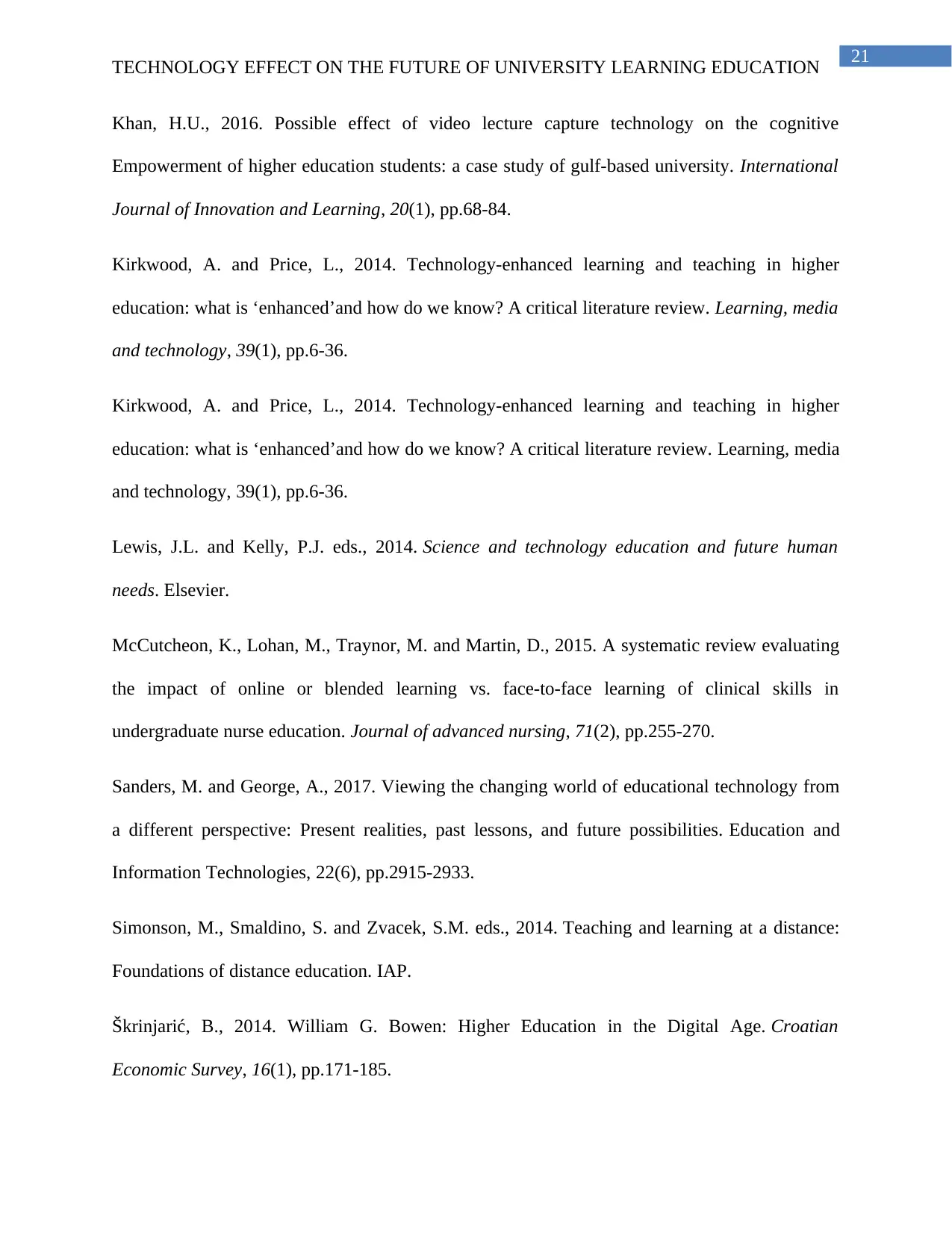
21
TECHNOLOGY EFFECT ON THE FUTURE OF UNIVERSITY LEARNING EDUCATION
Khan, H.U., 2016. Possible effect of video lecture capture technology on the cognitive
Empowerment of higher education students: a case study of gulf-based university. International
Journal of Innovation and Learning, 20(1), pp.68-84.
Kirkwood, A. and Price, L., 2014. Technology-enhanced learning and teaching in higher
education: what is ‘enhanced’and how do we know? A critical literature review. Learning, media
and technology, 39(1), pp.6-36.
Kirkwood, A. and Price, L., 2014. Technology-enhanced learning and teaching in higher
education: what is ‘enhanced’and how do we know? A critical literature review. Learning, media
and technology, 39(1), pp.6-36.
Lewis, J.L. and Kelly, P.J. eds., 2014. Science and technology education and future human
needs. Elsevier.
McCutcheon, K., Lohan, M., Traynor, M. and Martin, D., 2015. A systematic review evaluating
the impact of online or blended learning vs. face‐to‐face learning of clinical skills in
undergraduate nurse education. Journal of advanced nursing, 71(2), pp.255-270.
Sanders, M. and George, A., 2017. Viewing the changing world of educational technology from
a different perspective: Present realities, past lessons, and future possibilities. Education and
Information Technologies, 22(6), pp.2915-2933.
Simonson, M., Smaldino, S. and Zvacek, S.M. eds., 2014. Teaching and learning at a distance:
Foundations of distance education. IAP.
Škrinjarić, B., 2014. William G. Bowen: Higher Education in the Digital Age. Croatian
Economic Survey, 16(1), pp.171-185.
TECHNOLOGY EFFECT ON THE FUTURE OF UNIVERSITY LEARNING EDUCATION
Khan, H.U., 2016. Possible effect of video lecture capture technology on the cognitive
Empowerment of higher education students: a case study of gulf-based university. International
Journal of Innovation and Learning, 20(1), pp.68-84.
Kirkwood, A. and Price, L., 2014. Technology-enhanced learning and teaching in higher
education: what is ‘enhanced’and how do we know? A critical literature review. Learning, media
and technology, 39(1), pp.6-36.
Kirkwood, A. and Price, L., 2014. Technology-enhanced learning and teaching in higher
education: what is ‘enhanced’and how do we know? A critical literature review. Learning, media
and technology, 39(1), pp.6-36.
Lewis, J.L. and Kelly, P.J. eds., 2014. Science and technology education and future human
needs. Elsevier.
McCutcheon, K., Lohan, M., Traynor, M. and Martin, D., 2015. A systematic review evaluating
the impact of online or blended learning vs. face‐to‐face learning of clinical skills in
undergraduate nurse education. Journal of advanced nursing, 71(2), pp.255-270.
Sanders, M. and George, A., 2017. Viewing the changing world of educational technology from
a different perspective: Present realities, past lessons, and future possibilities. Education and
Information Technologies, 22(6), pp.2915-2933.
Simonson, M., Smaldino, S. and Zvacek, S.M. eds., 2014. Teaching and learning at a distance:
Foundations of distance education. IAP.
Škrinjarić, B., 2014. William G. Bowen: Higher Education in the Digital Age. Croatian
Economic Survey, 16(1), pp.171-185.
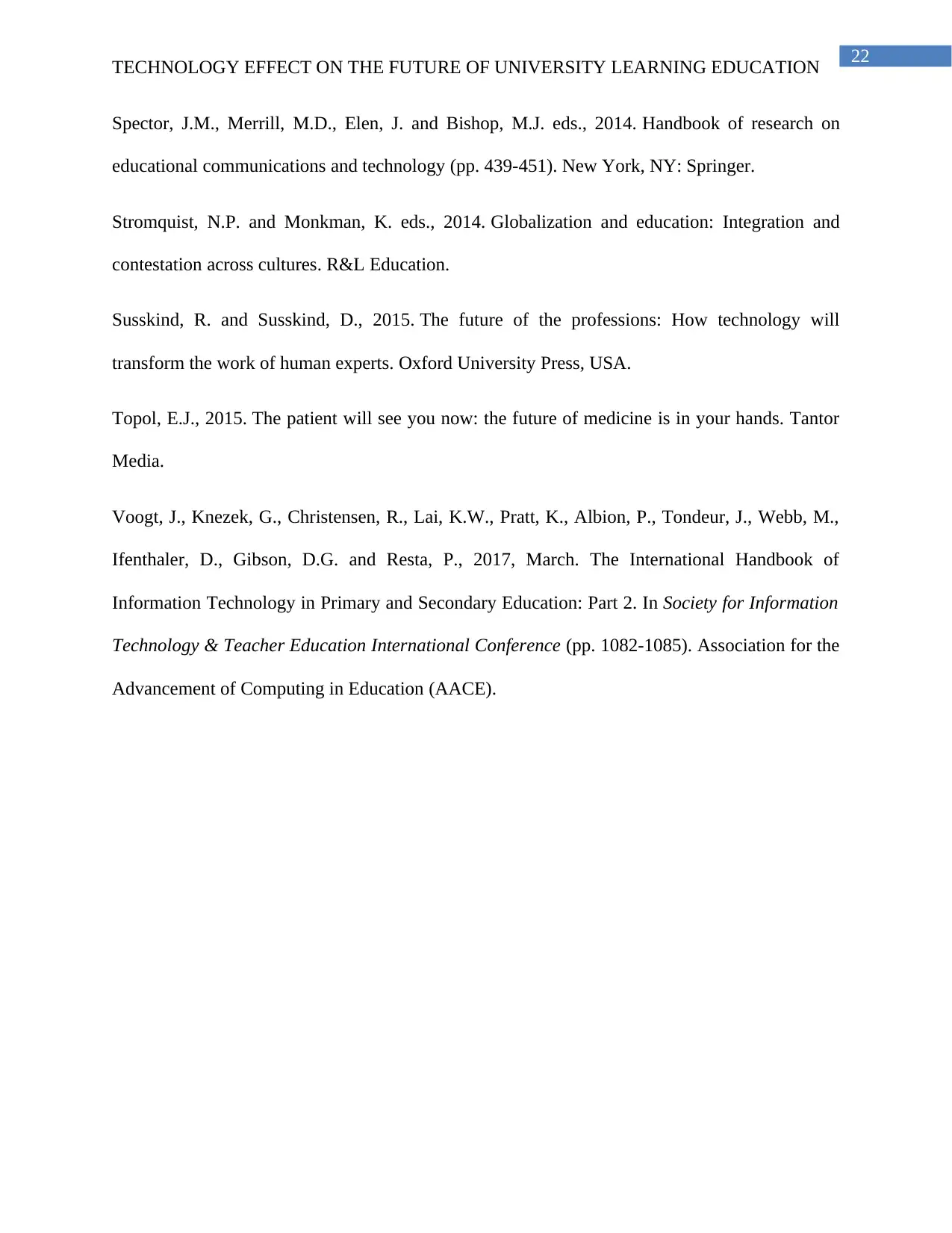
22
TECHNOLOGY EFFECT ON THE FUTURE OF UNIVERSITY LEARNING EDUCATION
Spector, J.M., Merrill, M.D., Elen, J. and Bishop, M.J. eds., 2014. Handbook of research on
educational communications and technology (pp. 439-451). New York, NY: Springer.
Stromquist, N.P. and Monkman, K. eds., 2014. Globalization and education: Integration and
contestation across cultures. R&L Education.
Susskind, R. and Susskind, D., 2015. The future of the professions: How technology will
transform the work of human experts. Oxford University Press, USA.
Topol, E.J., 2015. The patient will see you now: the future of medicine is in your hands. Tantor
Media.
Voogt, J., Knezek, G., Christensen, R., Lai, K.W., Pratt, K., Albion, P., Tondeur, J., Webb, M.,
Ifenthaler, D., Gibson, D.G. and Resta, P., 2017, March. The International Handbook of
Information Technology in Primary and Secondary Education: Part 2. In Society for Information
Technology & Teacher Education International Conference (pp. 1082-1085). Association for the
Advancement of Computing in Education (AACE).
TECHNOLOGY EFFECT ON THE FUTURE OF UNIVERSITY LEARNING EDUCATION
Spector, J.M., Merrill, M.D., Elen, J. and Bishop, M.J. eds., 2014. Handbook of research on
educational communications and technology (pp. 439-451). New York, NY: Springer.
Stromquist, N.P. and Monkman, K. eds., 2014. Globalization and education: Integration and
contestation across cultures. R&L Education.
Susskind, R. and Susskind, D., 2015. The future of the professions: How technology will
transform the work of human experts. Oxford University Press, USA.
Topol, E.J., 2015. The patient will see you now: the future of medicine is in your hands. Tantor
Media.
Voogt, J., Knezek, G., Christensen, R., Lai, K.W., Pratt, K., Albion, P., Tondeur, J., Webb, M.,
Ifenthaler, D., Gibson, D.G. and Resta, P., 2017, March. The International Handbook of
Information Technology in Primary and Secondary Education: Part 2. In Society for Information
Technology & Teacher Education International Conference (pp. 1082-1085). Association for the
Advancement of Computing in Education (AACE).
1 out of 22
Related Documents
Your All-in-One AI-Powered Toolkit for Academic Success.
+13062052269
info@desklib.com
Available 24*7 on WhatsApp / Email
![[object Object]](/_next/static/media/star-bottom.7253800d.svg)
Unlock your academic potential
© 2024 | Zucol Services PVT LTD | All rights reserved.





